|
|
Post by dbutler69 on Jun 9, 2021 8:54:42 GMT -5
Star Wars #80Cover dated: February 1984 Issue title: EllieScript: Mary Jo Duffy Artwork: Ronald Frenz (breakdowns)/Tom Palmer (finished art & inks) Colours: Glynis Wein Letters: Joe Rosen Cover art: Ronald Frenz (pencils)/Tom Palmer (inks) Overall rating: 9½ out of 10 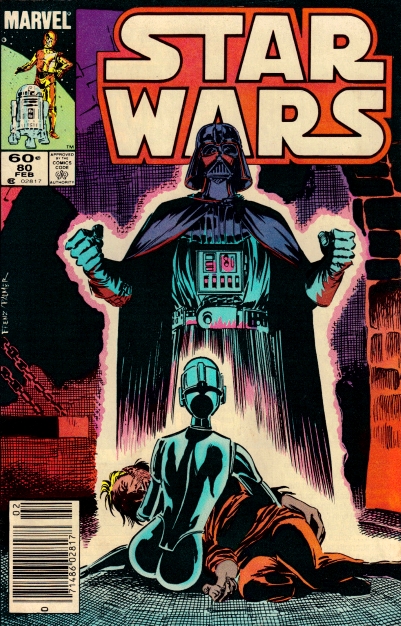 Plot summary Plot summary: Having gained entry to an Imperial supply depot, Luke Skywalker, Princess Leia, and C-3PO are disappointed to find that the trail for Tay Vanis has gone cold and there is no sign of the missing Rebel spy. They ask a droid named LE-914 – or "Ellie" for short – to search for Vanis's name in the docking records, but as soon as the droid does so, a pre-programmed alarm sounds and a squad of Imperial stormtroopers appear to apprehend the Rebels. During the ensuing firefight, "Ellie" saves 3PO's life by deflecting the energy from a blaster bolt with her own custom shielding. Escaping from the Imperials, Luke, Leia and the droids reach the Millennium Falcon and take off, as "Ellie" directs them to an abandoned castle that was Vanis's last known location. As they near the stronghold, they spot the missing spy's downed X-wing fighter in the undergrowth and land nearby. The Rebels recover a holographic recording from Vanis's ship, in which the missing spy tells of obtaining the secret datatapes relating to the Empire's new secret weapon from Bothan spies and narrowly escaping Darth Vader. Vanis also reveals that he has left the tapes with his droid, LE-914, who has been instructed to destroy them if a Rebel rescue hasn't found him within two days. The Rebels are stunned to learn that the tapes were with "Ellie" all along, but turning to question the droid, they realise she has disappeared while they were watching Vanis's message. Entering the castle in search of "Ellie" and Vanis, the Rebels manage to take an Imperial officer hostage and question him about the missing Rebel. The terrified officer shows them to a locked room where there is apparently some information about Vanis, but as the officer unlocks the door, a life-size hologram of Darth Vader appears. The flickering image of the Sith Lord tells Luke that he has foreseen that Skywalker would come to rescue Vanis and explains that he had, in fact, captured the Rebel spy some time ago. Vader kept Vanis in the castle and concealed him from everyone except the troops at the installation, in order to lead the Rebels on a futile chase and keep them occupied, while at the same time, keeping his more ambitious officers tied up with searching for the missing spy too. As the hologram fades, Vader offers the Rebels the contents of the room behind the locked door. Inside is the tortured, haggard form of Vanis himself, now in a permanently catatonic state as a result of his treatment at Vader's hands. As the Rebels stare in horror, "Ellie" appears behind them and informs the Rebels that Imperial troops are already on their way to apprehend them. She claims that there is no time to take Vanis with them and that saving his life in this state would not necessarily be a kindness. The droid hands the missing datatapes to 3PO, explaining that she had kept them safe because she believed that the Rebels would eventually come for her master. As Luke, Leia and 3PO watch, LE-914 cradles Vanis in her arms and self-destructs, killing them both. Before leaving the planet, the Rebels sabotage the castle's power station, destroying the stronghold as a monument to both Vanis and his droid. Comments: Star Wars #80 features the final instalment of the long-running Search for Tay Vanis story arc, which began all the way back in Star Wars #73, "Lahsbane". Interestingly, a pre-publication solicitation for this issue, published some five months earlier in Marvel Age #7, shows that the original title for this issue was "Lady", rather than "Ellie". Personally, I'm glad that Marvel saw fit to change the name before it saw print; "Ellie" is a far better title. But since the name "Ellie" is derived from LE-914, I can't help wondering if Vanis's droid was originally designated something like LA-D914 or similar, and that's how the earlier title came to be? Anyway, that aside, LE-914 is definitely one of the more memorable characters – especially droid characters – from Marvel's original Star Wars series. I've always really liked her sleek, feminine design and the Wookieepedia website informs me that, actually, the droid's appearance was based on early production sketches of C-3PO that artist Ralph McQuarrie had done in the mid-'70s. In the story it's hinted that "Ellie" is an older model than 3PO, which is no doubt a subtle reference to her appearance pre-dating his final design. Here's some of McQuarrie's concept art for 3PO, with a comparison picture of LE-914 on the far right... 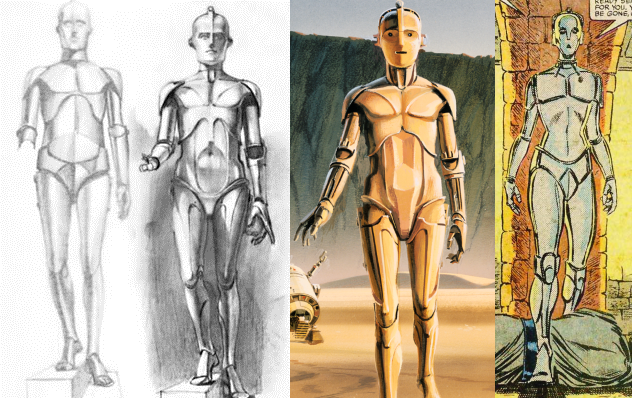 Jo Duffy turns in a very poignant script here, which includes some thought-provoking stuff concerning the bond between humans and droids, as well as inter-droid relationships too. For example, there's obviously an extremely strong bond between LE-914 and Tay Vanis. So much so that, when she sees that Vanis has been tortured until he looks to be totally catatonic and/or insane, "Ellie" self-destructs, killing both Vanis and herself, while she cradles the tragic form of her master in her arms. That's an extremely selfless act on the droid's part and you can sort of imagine 3PO or R2-D2 doing the same thing for Luke, if it really came to it. What's weirder though is 3PO's relationship with "Ellie". The way that Duffy writes it, it's almost as if the golden protocol droid is falling in love with her, or at least forming a decidedly human-like emotional bond with the female droid. But, since droids don't really feel love, it must just be a case of 3PO feeling tremendous respect or gratitude towards "Ellie" for saving him from an Imperial blaster bolt earlier in the story. As for the final image of 3PO in the rain (see below), with the water puddling in the droid's eye recesses and then trickling down his face – giving the appearance of tears – I might be in the minority when I say that I've always found it to be a bit over the top. I know that it's all supposed to be tremendously poignant and all – and maybe I'm just a hard-hearted S.O.B. – but even as a kid this panel kind of made me roll my eyes. Still, I'd be lying if I said it wasn't one of the most memorable single panels of the entire series. During an interview with the jedinews.co.uk website in 2011, penciller Ron Frenz recalled the creation of that memorable final page, noting, " It was all on the page as written by Jo Duffy, down to the rain serving as C-3P0's tears. That was ALL Jo and a fantastic story to be part of." Frenz also picked the front cover of issue #80 as his favourite of all the covers that he did on the series. While I may not be totally bowled over by the panel of 3PO "crying" for Vanis and LE-914, I do agree with Frenz that the story in this issue is absolutely top notch. Duffy really does knock it out of the ballpark for the climax of this extended storyline. The characterisation of Luke, Leia and 3PO is perfect, the plotting is tight and the script has plenty of action and excitement, as our heroes finally close in on the object of their search. Duffy also sets the stage for Return of the Jedi quite well in this issue and it should be noted that Luke is seen wearing the garb that he would wear in that film for the first time (chronologically speaking). There's even an advert for Marvel's adaptation of Jedi at the end of this issue, which informs us that the events of that film immediately follow the events of this issue. I do have a few minor problems with some of the plot elements in this story though, such as Duffy never telling us the name of the planet that Vanis is found on, although we do learn that it's not too far (in galactic terms) from the planet Lahsbane. Also, why are Luke and Leia travelling to an Imperial facility on an Empire held world in the Millennium Falcon? Surely the ship would be recognised? Finally, it's never made wholly clear why Vader bothered keeping Vanis alive. The Sith Lord had already succeeded in making Luke chase all over the galaxy looking for the missing Rebel, so why did he need to leave him alive? Unless it was simply to rub Luke's nose in it, when he did eventually find the shattered form of his quarry. We know from what the Emperor said in Return of the Jedi that the Rebels were always intended to find the plans that the Bothan spies had obtained and, as such, Vader would've had no interest in retrieving them from Vanis, so he definitely wasn't keeping the Rebel alive to interrogate him. "Ellie" speculates that Vader kept Vanis alive as an extended form of torture, but Duffy never makes it totally clear what Vader's rationale was. Actually, on a related subject, I should just note that this issue represents the first time that it's explicitly stated that Vanis was in possession of the information that the Bothan spies, who are mentioned in Return of the Jedi, had obtained. Frenz and inker Tom Palmer's artwork in this issue really is sumptuous, with both of them at the top of their game. A number of pages feature long rectangular panels, which serve to heighten the sense of tension and give proceedings a tight, claustrophobic quality that works very well for this tense finale to the Search for Tay Vanis. I also really like how the first three pages of this issue show us a tense scene in which Luke, Leia and 3PO anxiously hide from a passing squad of stormtroopers. The artists do a fantastic job of conveying the tension of this scene, which serves to suck the reader straight into the unfolding drama, wondering whether the heroes are going to be discovered or not. In truth, this sequence doesn't really have all that much to do with the story, other than it taking place in the Imperial supply station that the Rebels are inside of, but it's a fantastically gripping way to kick off the issue. As an aside, how those stormtroopers failed to hear 3PO's blabbing, I'll never know! Summing up, "Ellie" is an intensely gripping and rather poignant story, with some stellar artwork. It brings the Search for Tay Vanis storyline to a satisfying conclusion and sets the stage for the events of Return of the Jedi rather well. Some of the sentimentality on show here is a little heavy-handed for my tastes and certain peripheral aspects of the plot leave me a little confused, so I'm gonna dock this issue ½ a point for that. But nonetheless, this really is one of the best issues of Marvel's original Star Wars run. Continuity issues: None. Favourite panel: 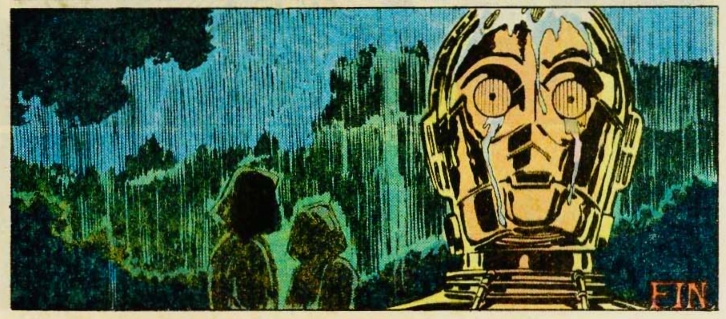 Favourite quote Favourite quote: "He was … a very great trouble to the Empire, many times. Do you think Darth Vader left him alive … as a kindness?" – LE-914 gives her interpretation of Darth Vader's rationale for sparing Tay Vanis's life. I think you may be onto something with the origin of LE-914’s look. Although this was a nice story overall, I did have some issues with LE-914's behavior. It seemed to human. She actually disobeyed Tay Vanis's orders, which I don't think a droid should be doing, and she seemed to grieved over his death at the end. I know droids in the Star Wars Universe often do appear to show emotion (such as Threepio often acting scared - though that could basically be self-preservation programming) but I felt that this went a bit too far. Also, the scene towards the beginning where quite a few stormtroopers marched in on Luke & Leia, our heroes took out those stormtroopers too easily. |
|
|
|
Post by dbutler69 on Jun 9, 2021 9:40:56 GMT -5
Star Wars #81Cover dated: March 1984 Issue title: Jawas of DoomScript: Mary Jo Duffy Artwork: Ronald Frenz (breakdowns)/Tom Palmer (finished art & inks)/Tom Mandrake (finished art & inks) Colours: Ken Feduniewicz (uncredited) Letters: Joe Rosen Cover art: Tom Palmer Overall rating: 10 out of 10 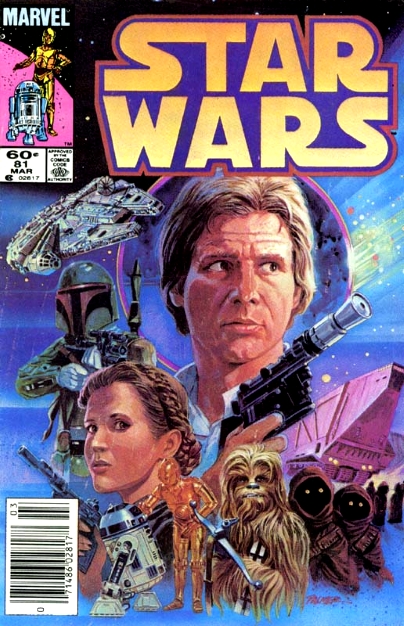 Plot summary Plot summary: The morning after the Battle of Endor and the Rebel Alliance's victory over the Empire, Princess Leia finds Han Solo in an irritable mood as a result of his not having any ready money available. Leia suggests that she or the Rebellion loan him some funds, but this angers Han and he storms off, telling Leia that he's always made it on his own in the past and that he doesn't belong to the Rebellion or anything else. Heading back to the Millennium Falcon, Han takes time to reacquaint himself with his freighter, having been away from her for almost a year, while he was frozen in carbonite and a prisoner of the bounty hunter Boba Fett. As Han wistfully explores the interior of the ship, Chewbacca boards the craft and hugs his partner, as Han is overcome with emotion. Some time later, Han, Leia, and R2-D2 leave for Tatooine in the Falcon, since Solo has remembered that he has some credits locked away in a bank account in Mos Eisley. Upon arriving at the spaceport town, Han learns that his account was been frozen and cannot be accessed because the banking computer believes that he is still in suspended animation. Meanwhile, out in the Dune Sea, Boba Fett has been regurgitated by the Sarlacc creature, which had swallowed and supposedly killed him during the battle on Jabba's Sail Barge. The unconscious form of the bounty hunter is picked up by a group of roaming Jawas, who mistake him for a droid and take him back to their Sandcrawler. Back in Mos Eisley, Leia suggests that R2 speak to the bank's computer to help them access Han's credits, but they find the little astrodroid missing and tiny footprints on the floor where they left him. Han deduces that R2 has been stolen by Jawas, so he and Leia appropriate a pair of landspeeders and head out into the Dune Sea to search for him. They soon catch up with the Jawas' Sandcrawler, which unbeknown to them also contains the unconscious body of Fett. As Han attempts to board the vehicle, he crashes his landspeeder into its Caterpillar-tracks, jamming the wheels and sending it accelerating toward the Sarlacc pit. The Sandcrawler then comes under attack from a tribe of angry Sand People. Between dodging laser blasts from the Jawas and the Sand People, Solo manges to rescue R2 from the doomed vehicle, but when he attempts to rescue Fett, the bounty hunter comes to his senses and, recognising Solo's face and name, opens fire on him. Han leaps from the Sandcrawler at the last moment, as it falls into the Sarlacc's maw and is swallowed, with Fett still on board. Comments: Well, here we are then – adventures beyond the original trilogy at last! Star Wars #81 is somewhat significant for being the first time in any medium that a post- Return of the Jedi story had been told, and – putting its appallingly bad and needlessly tongue-in-cheek title aside for a second – I reckon this is a pretty fantastic start. In fact, I'm gonna pin my colours to the mast right now and say that this comic is hands down my favourite single issue of the entire run. Hell, I even picked it as my all-time favourite comic of any run in the forum's 2014 Classic Comics Christmas event. Let's begin with that front cover, and what about it, eh? I've noted before how lucky Star Wars fans were to have had inker Tom Palmer working on the comic, but his painted cover for this issue is just something else. Let's have a look at a bigger version of it, shorn of the book's logos, as it was originally rendered... 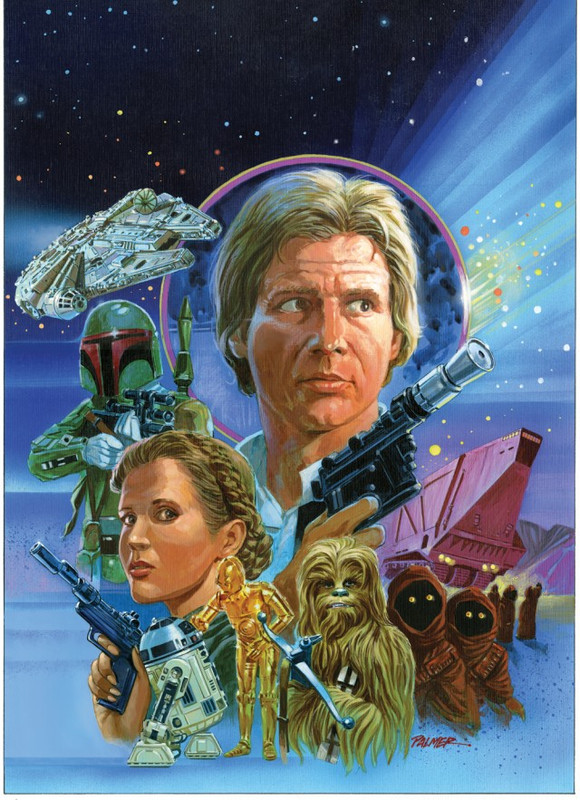 This movie poster-esque painting is so gorgeous and Palmer's likenesses of the cast so good that your humble reviewer even has it on a t-shirt, dear readers...   If anything, the story inside is even more impressive than the cover. "Jawas of Doom" (man, how I hate that title!) is a stand alone, done-in-one story that begins the day after the Ewok celebration at the end of Return of the Jedi and, judging from comments made by Wedge Antilles and Lando Calrissian, it certainly seems as if the Ewoks know how to throw a party! Writer Jo Duffy very much focuses on Han Solo in this issue and shows us something of the emotional toll that losing close to a year of his life encased in carbonite has taken on him. We see the Corellian smuggler adjusting to being back among the living, with the attendant money troubles that this has brought him. Duffy examines whether or not a freewheeling individual like Han can ever really become a team-player in a structured organisation like the Rebellion. We see him torn between playing the part of the honoured war hero and his tendency towards being a natural-born scoundrel. Duffy also takes an opportunity to show us just how far out of touch with the real galaxy Solo has become, during a conversation with a character named Garrick in Mos Eisley... 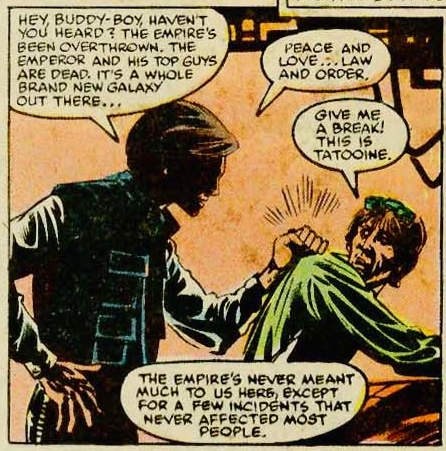 There are also some rather tender moments in the story, such as when we see Leia trying to comfort Han in a Mos Eisley cantina and coax him through his soul searching...  The underlying theme of this issue is how Han is going to adapt to this brave new galaxy that he finds himself in. The Empire is no more and Jabba the Hutt is dead, but will he settle down and remain a part of the Rebel Alliance or return to his former life of smuggling? Of course, Star Wars: Episode VII – The Force Awakens has shown us that, actually, both of these things happened in the years following Return of the Jedi, but you've really got to hand it to Duffy for addressing these difficult questions as soon as she possibly could and as early as 1983, which is when this comic was written. Don't get me wrong though, it's not all angst and introspection: there's plenty of action in this issue and the scripting is as excellent as ever, with Duffy capturing the "voices" of Han and Leia so well that you can almost hear Harrison Ford and Carrie Fisher delivering the dialogue. There's also a decent amount of humour and a gripping, action-packed climax too, featuring the brief return of Boba Fett. From things that I've read online over the years, it seems as if many Star Wars fans had a problem with Duffy resurrecting Fett, but personally, I think it was a bold and exciting move. Fett's appearance lends this issue a "classic" feel and a level of significance that it might not otherwise have had. Speaking to comics historian Glenn Greenberg in Back Issue #9 from 2005, Duffy recalled how hard she petitioned the book's editor Louise Jones to allow her to use Fett: " We were getting away with murder even attempting that story. There was a very strict hands-off edict issued on Boba Fett. I really wanted to use him, so I argued passionately to Louise that if we took him out, played with him a bit, and put him back where we got him, we'd have satisfied our own and the audience's ongoing jones for some Fett action, without having breached any of Lucasfilm's rules. Louise agreed to let us try, and no one at Lucasfilm fired any shots when we ran the plot up the flagpole." To my mind, bringing Fett back because the Sarlacc found him indigestible was fine and rather exciting if you were a fan of the character, which I most definitely was. However, dumping him back into the Sarlacc at the end of the story – inside a small Jawa Sandcrawler, no less – seems a little bit contrived, although as the above quote shows, it was necessary from Duffy and Marvel's point of view. Actually, while we're on the subject of Fett, it seems pretty unlikely to me that such seasoned scavengers as the Jawas would initially mistake him for a droid. I mean, surely they could've just taken his helmet off? For his part, Fett actually spends a lot of this issue unconscious or suffering from amnesia, but he does regain his senses near the end, when he tries to kill Han. Duffy writes Han very much as a hero at heart during this scene, although the Corellian does struggle with the temptation of letting Fett die... 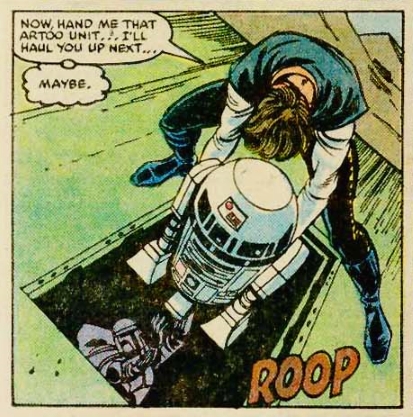 This is yet another example of how Duffy gives us a very nuanced, mature and human portrayal of the Corellian smuggler in this issue. It's also a good example of the little character moments that Duffy sprinkles liberally throughout the comic and, ultimately, it's these moments that make this issue such a joy to read. For example, there's an emotional and touching scene in the Falcon's cockpit, in which Han, overwhelmed by all that has happened to him recently, breaks down in Chewbacca's arms...  Another little character moment that I absolutely love is when we see Chewie napping with some Ewok babies in the treetop village. Duffy demonstrates a formidable knowledge of Star Wars minutia too, when she has Han examine the dice he won the Falcon with. Those dice only appeared in a few blink-and-you'll-miss-them scenes in Star Wars: Episode IV – A New Hope, so full marks to Duffy for incorporating them into this issue. Something that puzzles me, however, is whether all of this issue takes places the day after Return of the Jedi. We learn from a denizen of Mos Eisley, who initially propositions Leia as if she's a street walker (what is it with Duffy and prostitutes lately?!), that since Jabba's death, the Jawas have become much more aggressive – even going so far as to attack the Sand People on occasion. This comment means that there must've been a delay of a few days, if not weeks, between the start of this issue and Han, Leia and R2 leaving Endor for Tatooine. The beginning of this comic definitely takes place the day after the destruction of the second Death Star, but if the scenes on the streets of Mos Eisley are occurring in the same time frame, then Jabba would've only been dead for a day or two at most, which obviously wouldn't allow time for things to change that much on Tatooine. On the subject of Tatooine, I should also note that there's what looks to be a tiny continuity gaff when Garrick mentions that the last time Han left Mos Eisley he failed to pay his docking fees, to which Han replies that he was "in a bit of a hurry." This is almost certainly a reference to the scene in Star Wars: Episode IV – A New Hope where Han blasts his way out of Mos Eisley in the Falcon, narrowly escaping the Empire's troops. However, within the Marvel continuity, Han had actually been back to Tatooine and Mos Eisley since then, in Star Wars #31 and #32. He last left the spaceport at the beginning of issue #33, but there's no mention in that comic of it being a particularly hurried departure, although it does mention that the Falcon's crew and passengers are relieved to have gotten off of the planet without attracting any unwanted Imperial attention. So, I suppose it's feasible that Garrick is, in fact, referring to that later departure, rather than the one seen in the original Star Wars film. As such, I'm gonna let this slide and not log it as an actual continuity problem. Something I will be logging, however, is the fact that the Millennium Falcon's sensor dish is still intact, despite it being knocked off inside the Death Star during the Battle of Endor, just the day before! As ever, Ron Frenz and Tom Palmer's artwork shines in this issue, but there's an additional inker this time, in the shape of Tom Mandrake. In 2011, Frenz told the jedinews.co.uk website that he ran late on this particular issue and that's why Mandrake was brought in. No doubt having Palmer tied up with painting that gorgeous cover was another reason why a second inker was needed. Mandrake inks the second half of this story and his work is noticeably different to Palmer's slick style, being slightly more "cartoony", for want of a better term. However, the transition between inkers isn't too jarring and Mandrake's work is quite inventive at times. I particularly like how he tries to create a motion blur effect in the panel where Han and Leia are speeding side by side across the plains of Tatooine in their landspeeders...  The effect is quite impressive and definitely gets the point across. This was in the days before digital manipulation of comic books made adding things like motion blurs relatively easy, so I think Mandrake does a very passable job under the circumstances. I should also note that Glynis Wein is erroneously credited with coloring this issue, when actually it was Ken Feduniewicz, as noted on the letters page of issue #85. Overall, this is simply a fantastic issue. It's great to finally have Han Solo back in the Star Wars comic again, and not as a carbonite slab or in a flashback sequence, which is how he'd made his few appearances since issue #43 (not counting the Return of the Jedi comic adaptation, of course). Although David Michelinie, Archie Goodwin and Jo Duffy all did a fantastic job of telling exciting stories without using Han, let's be honest, Solo is one of the best things about the Star Wars saga, so he was always going to be a sorely missed member of the main cast. Star Wars #81 is a bold, daring comic, in which Duffy resurrects Boba Fett and examines the difficult subject of Solo's post-carbon freeze dislocation with aplomb. This is Duffy at the height of her powers. She's in complete control of her characters here, firing on all cylinders, supremely confident and delivering an exciting, fast-paced adventure that really does feel like a Star Wars film. If I could give this issue 11 out of 10, I would. Continuity issues: - The Millennium Falcon is shown as still having its sensor dish intact, when it had been destroyed during the Battle of Endor, only the day before this issue takes place.
Favourite panel: 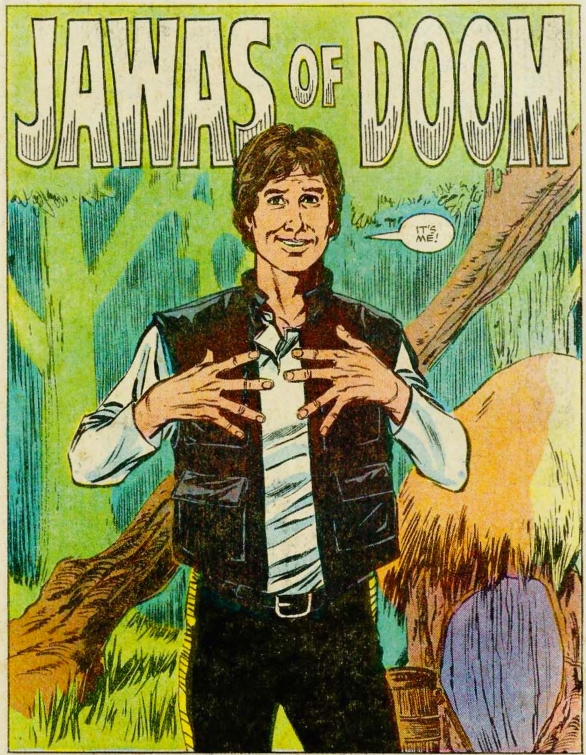 Favourite quote Favourite quote: "No … No, I'm not, uh … working. I'm waiting for a friend. He has business inside." – A flustered and shocked Princess Leia explains to an alien what she's doing, after being mistaken for a prostitute. Oh boy. I had a lot of problems with this issue. It’s true that Duffy tackles some logical issues, such as Han’s place in this Brave New Galaxy, and a bit of difficulty in dealing with the fact that he was frozen for several months (though it seems like the events of Return of the Jedi should have forcibly shaken him out of that) but I still didn’t much care for this issue, unfortunately. Leia and Han’s relationship seemed to actually be going backwards a bit here, as they acted more like a couple that’s been on a couple of dates, in my humble opinion. And Leia is "a good copilot"? Since when? I also find a really hard time accepting the Jawas all of a sudden becoming so bold and dangerous. The Jawas are almost as dangerous as the sandpeople? Please. It was also odd seeing the sandpeople wearing blue robes. I also thought the reasoning behind why Han couldn’t get his money back (out of a bank?) was pretty silly. Also, count me as somebody who didn’t like having Boba Fett have survived. I know he was also resurrected elsewhere in the Expanded Universe, but I really don’t like it. Also, the Tusken Raiders had more firepower than I think they’re really capable of when they blaster the landspeeders and the Jawa transport. The laser blasts there looked like they came out of an ion cannon! Overall, I thought the art here was strong, though. Edit: Beautiful cover, though. |
|
|
|
Post by badwolf on Jun 9, 2021 9:51:49 GMT -5
Star Wars #53Cover dated: November 1981 Issue title: The Last Gift from Alderaan!Script: Chris Claremont Artwork: Walter Simonson (pencils)/Carmine Infantino (pencils)/Tom Palmer (inks)/Alan Kupperberg (inks) Colours: Glynis Wein Letters: Shelly Leferman Cover art: Walter Simonson Overall rating: 6 out of 10 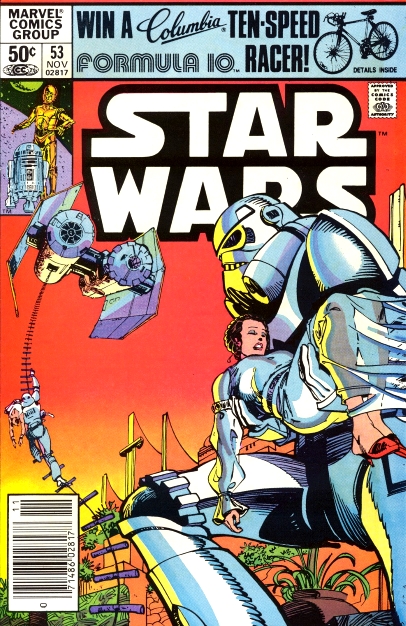 Plot summary Plot summary: While on a mission to investigate Imperial activity in the remote Shiva system, Princess Leia's ship and the docked shuttle craft she is in are both damaged by a space mine. Launching the crippled shuttle in an attempt to prevent further damage to the Rebel mother ship, Leia crash lands on Shiva IV, where she is attacked by a band of savage alien warriors. She is saved by a group of friendly natives, led by Aron Peacebringer and Kéral Longknife, who rescue the princess and return with her to the capital city of Illyriaqüm. Some weeks later, Leia is still living in Illyriaqüm among the Calians, who are the native human inhabitants of Shiva IV. The princess attempts to warn Aron and his wife Alisande about the dangers of the Empire, but the warlord is not convinced that such a threat really exists. Little does Aron know that his comrade Ygal Delois is in league with the Imperials and is planning a coup d'état, after which he will supplant Aron as the planet's ruler. Later, at a ceremonial ball for the Calian nobility, Aron admits to his wife that he has feelings for Leia, while Alisande tells him that he must choose between the two of them. Aron follows Leia outside, where he and the princess are both attacked and abducted by huge Imperial stormtroopers, before being brought before General Sk'ar as prisoners. Comments: What's this? The return of artist Carmine Infantino to the pages of Marvel's Star Wars comic? Well, sort of. The bulk of this issue originates from an unused story that Infantino had drawn for Marvel's John Carter: Warlord of Mars series. Apparently, by mid-1981, a number of Marvel's comic books were starting to slip behind schedule and miss shipping dates, so Editor-in-Chief Jim Shooter came up with the solution of reusing left over art inventory from various cancelled series and re-working it into the company's ongoing books. Thus, the editor of Star Wars, Louise Jones, was given left over art from the cancelled John Carter comic. Chris Claremont was then asked to re-work that art into a Star Wars story, with Walter Simonson adapting and adding to Infantino's pages where needed. Of course, anyone who is familiar with the John Carter comic will plainly recognise the figures of John Carter, Dejah Thoris and Tars Tarkas, who are renamed here as Aron Peacebringer, Alisande and Kéral Longknife respectively, while Shiva IV is obviously Mars (or, more accurately, Barsoom). When fans later wrote in noting the similarities between the characters in Star Wars #53 and the John Carter comic, Marvel simply passed it off as having being "inspired" by the John Carter stories, rather than revealing the true origin of the issue. Personally, I've always felt that the John Carter-esque setting of this issue seems a little out of place in a Star Wars comic. Edgar Rice Burroughs's John Cater novels are widely considered to be the granddaddy of all space opera and they were certainly influential on George Lucas when he was developing Star Wars, so the merging of the two franchises should theoretically work. However, in spite of the admirable attempt that Claremont and Simonson make to mold a Star Wars tale from a John Carter story, the Barsoomian setting looks a little too different to the "used galaxy" aesthetic that we've come to expect from Star Wars to be truly successful. Still, I guess Claremont resolves the jarring differences between Burroughs's setting and Lucas's somewhat by having the Shiva system be on the edge of known space. On the artistic front, something I really want to make note of here is that Simonson and inker Tom Palmer do a fantastic job of aping Infantino's style on the first 5 pages of this story. The pair had to imitate Infantino's style to the greatest possible degree in order that this framing sequence, along with whatever new panels or alterations were necessary to turn the Barsoomian story into a Star Wars one, fit together with Infantino's existing work to form a cohesive whole. Just look at page 3 for example: it's a dead ringer for Infantino's work and yet, it's not drawn by him at all...  Simonson gave some details about the creation of this issue in a 2015 post on his official Facebook page... "The basic idea was to use as many of the [John Carter] pages as possible with as few changes as possible. Some extra pages had to be done and some panels altered to a greater or lesser degree to get everything to fit together. That was my job, along with the covers. I don't know that it was the best way to make comics, but it was an interesting intellectual puzzle to try to solve in a readable fashion. It was fun, challenging, interesting and curious to do, whatever the final outcome."Simonson goes on to reveal that the reason that there are giant Imperial stormtroopers in this issue and on the front cover is because they were converted Tharks, which, in case you don't know, are 15 foot tall Barsoomian aliens. I can vividly remember how weird it seemed to me back in 1981 to have stormtroopers of such a gigantic size and this is definitely one aspect in which the story feels decidedly un- Star Wars-y. As an aside, not only does Simonson do a grand job of imitating Infantino, in one panel he inserts a cheeky little swipe from Howard Chaykin and Steve Leialoha's adaptation of Star Wars: Episode IV – A New Hope. Check out this image of panel 2, page 3 (on the left) juxtaposed with Chaykin and Leialoha's take on Kenobi from Star Wars #2 (on the right)... 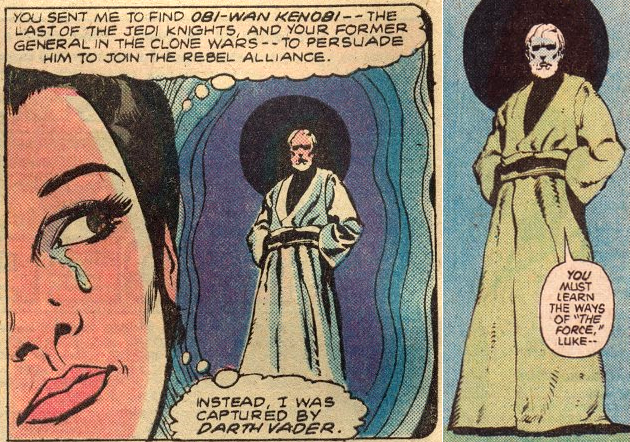 While we're on the subject of artwork, check out the gorgeous cover that "The Last Gift from Alderaan!" had in the UK, when it was published in Star Wars: The Empire Strikes Back Monthly #143...  I've including the above cover because this is how I first experienced this issue as a kid living in England and also because it's one of my favourite Marvel UK Star Wars covers. Unfortunately, I have no idea who the artist is. Anybody got any ideas? Claremont's writing of Princess Leia in this comic is very interesting. I love that we get to see the terrible burden of leadership on her shoulders, coupled with understandable "survivor's guilt" over the destruction of her homeworld by the Empire, and how that loss spurs the princess on as a Rebel warrior. We also see Leia beginning to enjoy the normal life she's now leading among the Calian nobility, which is kind of how she would have lived had the Rebellion not started and Alderaan not been destroyed. The vulnerability the princess exhibits here makes her all the more human and makes this issue one of the most compelling and believable examinations of Leia's character we've seen in the series so far. It's also kinda neat to see Leia through the eyes of an outsider like Aron Peacebringer, who understandably has a crush on her. To him, she seems very exotic, with her lighter skin colour and cute foreign accent when she's speaking Calian. As for Aron himself, unsurprisingly he seems like an almost identical character to John Carter and much of this issue is narrated by him in the first-person, just as Carter narrated his own adventures in the John Carter: Warlord of Mars comic. Aron's wife, Alisande, is a strong character and certainly a wise woman, who acts as her husband's lover, confidant and political adviser. It's also a nice touch on Claremont's part that initially Leia doesn't understand the language that the Calians of Shiva IV speak. All too often in the Star Wars comic – hell, not just in the comic, but in the films too! – characters from the various star systems speak perfect "Galactic Standard". By having the Calians speak in a tongue that neither Leia, nor her translatorcomp, can understand, Claremont reinforces the notion that Shiva IV is an extremely remote planet and very different from the rest of the Star Wars galaxy. As for General Sk'ar, who serves as the main Imperial villain in this issue and the next, he, like the giant stormtroopers at his command, was no doubt originally meant to be a Thark and has been redrawn as a towering, purple-skinned alien. In the years since this issue was published, it's been suggested by various expanded universe writers that the Empire is an institutionally racist organisation when it comes to non-human types and, as a result, none of their officers or leaders are alien, like Sk'ar is. Of course, back in 1981, there was no real reason why Sk'ar couldn't be an Imperial general, but why isn't he wearing an Imperial officer's uniform? I mean, if the Empire can stretch to providing extra large stormtrooper armour for his troops (who, I assume, are all of the same race as Sk'ar), why can't the Imperial tailors knock up a uniform for him? It's only a little detail, but the way Sk'ar is dressed kinda bugs me. Something else that bugs me is how the fire on the Rebel cruiser can continue to burn in the vacuum of space. At one point, the ship's first officer even states that the ship is open to space and loosing air because of the damage caused by a space mine, so how could the fire really be a threat? That doesn't make sense at all. There's also a minor continuity error in the opening pages of this comic, when the Rebel ship that Leia is on is referred to as a Rebel blockade runner, despite Simonson's art clearly showing that it isn't. Overall, Star Wars #53 is a weird one and definitely not one of Claremont's better efforts on the series. Of course, that's no doubt due, at least in part, to his having to re-work a John Carter: Warlord of Mars story into a Star Wars one, using pre-existing artwork. That's a horse before the cart way of producing a comic and, I suppose, it's a tribute to his talents – as well as those of Simonson – that it works as well as it does. Still, I remember as a kid thinking that this issue was a bit dull, stylistically at odds with the look and feel of the Star Wars universe, and not really in keeping with the flavour of other recent issues. As an adult, my opinion hasn't changed at all. Continuity issues: - The starship that Leia begins her mission on is described as being a Rebel blockade runner, yet it looks like an entirely different vessel.
Favourite panel: 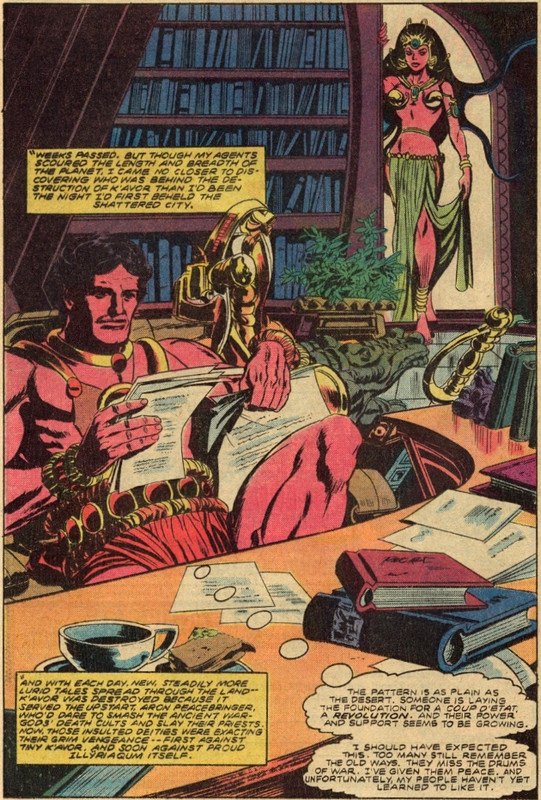 Favourite quote Favourite quote: "Tonight, Aron -- dancing, talking...flirting -- I was happy. I had no cares, no responsibilities. I saw a part of myself I've denied ever since the Rebellion began. I wasn't Leia Organa -- princess-senator, Rebel leader, warrior. I was a woman -- no more, no less -- enjoying myself at a fabulous party. I forgot...too much." – Princess Leia mournfully explains to Aron Peacebringer how much she feels the burden of duty to the Rebellion. Thanks for shedding light on this very strange issue. I noticed the John-Carterness and also wondered about the giant stormtroopers and you have cleared both up for me! I should have guessed that it was a repurposed story. |
|
|
|
Post by badwolf on Jun 9, 2021 9:58:47 GMT -5
Star Wars #58Cover dated: April 1982 Issue title: Sundown!Script: David Michelinie (plot, script)/Walter Simonson (plot) Artwork: Walter Simonson (pencils)/Tom Palmer (inks) Colours: Don Warfield Letters: Janice Chaing Cover art: Walter Simonson Overall rating: 8½ out of 10 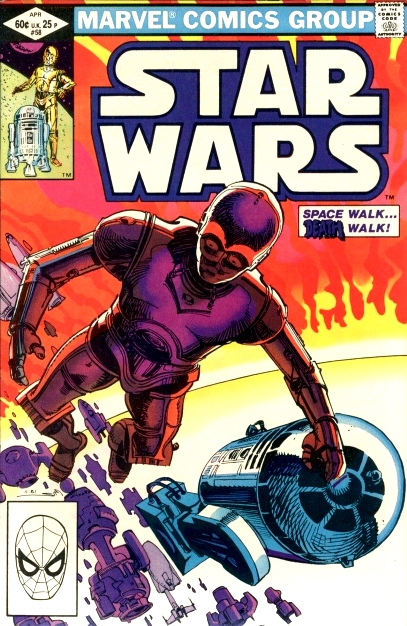 Plot summary Plot summary: The Rebel fleet is about to undertake a bold manoeuvre of Princess Leia's devising, in which it will be concealed within a large pyramid-shaped force field and then moved into the chromosphere of the planet Arbra's sun, away from prying Imperial eyes. As the Rebel ships move into position, Leia boards a shuttle craft bound for the Rebel base on Arbra. No sooner has the shuttle launched than Leia receives a worried message from C-3PO, who has been accidentally left aboard one of the generator ships that sustain the force field. The golden protocol droid explains that R2-D2 has detected that the generators powering the protective shield have malfunctioned and burning circuitry has flooded the maintenance bay with noxious fumes, knocking out the technical crew. With the droids consequently the only ones onboard the ship able to help, R2 devises a plan to save the fleet. The droids leave the generator ship on a space-walk and rig up an energy cable between the vessel and a nearby Rebel star-cruiser, bolstering the fluctuating generator's shielding capacity and saving the fleet. Elsewhere, having departed the planet Arbra in the Millennium Falcon, on a mission for the Rebellion, Lando Calrissian, Luke Skywalker and Chewbacca arrive at a space station known as Bazarre in order to rendezvous with a merchant named Orion Ferret. Docking their freighter, Luke and Lando enter the station and proceed to the marketplace location where they are supposed to meet the merchant. Suddenly, armed guards appear and hold the two Rebels at gunpoint, as Lando correctly surmises that their antagonists are in Ferret's employ. Comments: Star Wars #58 is basically a stand alone story, although the scenes centring on Lando Calrissian, Luke Skywalker and Chewbacca's trip to the space station called Bazarre provide a lead-in to the next issue. It's kinda fun seeing Luke, Lando and Chewie together like this because it's an unusual mix of cast members, in terms of what we had previously seen in the comics and films. We'll get more of these usual groupings of cast members as David Michelinie's run progresses and they're always a lot of fun. The scripting here is as entertaining as ever and, in particular, I love the snatches of random conversation that Michelinie writes for the traders in the Bazarre marketplace. These cries from the exotic array of vendors really give us a sense of the bustling atmosphere and hard-nosed wheeling and dealing that's going on at this locale. Also, the scene in which Lando and Luke play a game of Novacrown at the Millennium Falcon's gaming table is one of my favourite parts of this issue. The cunning way that Lando, the experienced gambler who is being soundly beaten by Luke, "accidentally" ruins the game, rather than loose, never fails to raise a smile... 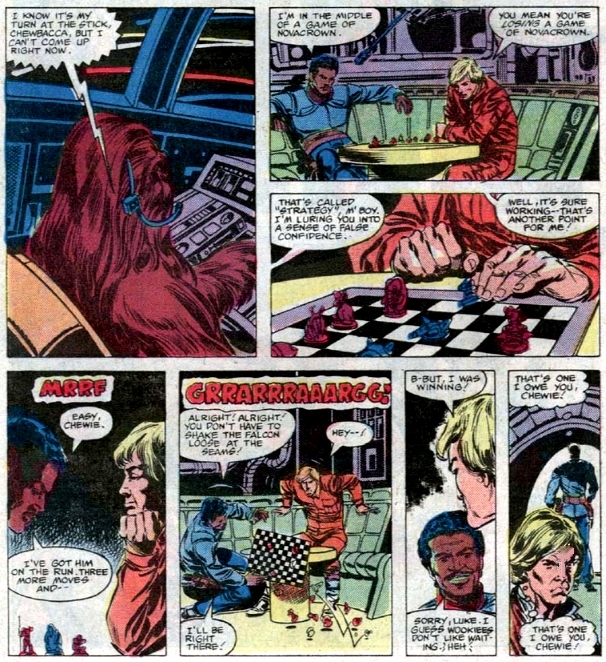 Of course, Walt Simonson's artwork has a large part to play in why this scene is so effective and so amusing. I really love Luke's annoyed face in that last panel.  Simonson also delivers a really nice nice splash page of the Falcon blasting off from Arbra base at the start of this issue, which is probably one of the best splash pages of the entire run. As for the main thrust of the issue, Princess Leia's plan to hide the entire Rebel fleet inside Arbra's sun has always seemed needlessly dangerous to me, but I also think that's a perfectly human reaction to it. Really, hiding the fleet inside the sun is a very logical and inventive way of preventing passing Imperial craft from spotting it. And really, given the advanced state of Star Wars technology, is being inside the sun any more dangerous that being in the vacuum of space? Both are deadly environments for most lifeforms. Also, although the galaxy is a big place, the Empire still managed to find the Rebels when they were hidden underground on a remote planet like Hoth, so simply having the fleet drifting around Arbra clearly isn't a safe option. As if to ram that point home, a passing Imperial TIE patrol suddenly enters the Arbra system just as the Rebel fleet is submerged into the chromosphere of the sun. Still, the nervous reactions of the various Rebels that we meet in this issue, along with Leia's private misgivings about the scheme, are entirely understandable. Speaking of various Rebels, we get to see more of the new supporting cast member Shira Brie in this issue. From the way Simonson draws Shira, she's definitely meant to be cute (as Plif the Hoojib notes), rather than stunningly beautiful. As such, she's very much in the feisty, no-nonsense Rebel warrior mold of Princess Leia, rather than being a glamorous space-temptress. There's also a nice bit of cattiness between Leia and Shira, which is fun to read. The latter quite blatantly hints that she and Luke really enjoy each other's company, to put it mildly, and Leia is definitely jealous of their relationship here. In hindsight, that is kind of icky, considering that Luke's her brother and all, but it makes some sense at this point in the continuity, given that the princess is unsure of exactly how she feels about Luke. I'm thinking specifically of that passionate kiss in the Rebel medical centre during The Empire Strikes Back, along with the pair's romantic interactions in the original Star Wars film. Later in the run, we'll see Leia privately agonising over exactly why Luke and Shira's relationship causes her such jealousy, when she's in love with Han Solo. This aligns nicely with George Lucas's later insistence that Leia had always had some kind of loving feeling for Luke, but didn't necessarily know that it was a sisterly love that she was experiencing. Something else that I want to make special note of in this issue is that, although this is only Shira's second appearance, I think that Michelinie and Simonson give the reader a subtly veiled clue about her true nature. When General Rieekan explains that they could loose the entire Rebel fleet if the pyramid-shaped force field collapses, Shira exclaims "How tragic!", but just look at the expression on her face...  That's an odd facial expression for someone who's just been told that everything she's supposed to hold dear could be lost at any moment. Looking at her face alone, it's almost as if her comment is sarcastic, but the exclamation point indicates that it sounds sincere to those standing around her. This panel takes on a much greater significance with later revelations about Shira. Something else that I want to mention is that we get a great example of Leia's stoic bravery in the face of overwhelming loss and defeat in this issue. When the princess thinks that the Rebel fleet is lost because her plan has ended in disaster, she looks distraught, but she has already resolved to start over again, to build more Rebel ships and recruit more members. To anybody else, the loss of the entire Rebel fleet would look like the end of the Rebellion itself, but she's resilient enough to want to carry on. This is the Leia that we saw in the films. A woman who lost her entire home planet and everyone she loved, yet stoically carried on as a Rebel figurehead in the face of an unimaginable loss. This really is some very in character writing from Michelinie. All in all, Star Wars #58 is quite a tense issue, as the Rebel Alliance undertakes a decidedly risky venture and it's an exciting read as a result. It's also nice to see R2-D2 and C-3PO save the day because it's not often in the original Marvel run that we get the droids acting as heroically as this and pulling the Rebel Alliance's fat out of the fire (pun intended). One minor niggle would be that having every single member of the maintenance crew succumbing to noxious fumes from burning circuitry and falling unconscious seems pretty unlikely and it's clearly just a plot contrivance to place the droids in jeopardy and have them save the day. Still, there's enough excitement, action and nicely executed character moments to make this issue a really entertaining read. Continuity issues: None Favourite panel:  Favourite quote Favourite quote: "I had some dealings with Ferret back when I ran Cloud City -- and I always came away from them feeling like I'd just slept in a slime pit!" – Lando Calrissian cautions Luke Skywalker about negotiating with the notorious merchant Orion Ferret. Simonson and Palmer knock it out of the park again. I agree that there are plenty of nice little snippets of dialogue by Michelinie. I especially love the way Luke and Lando both say "That's one I owe you, Chewie" with totally opposite meanings. Clever writing. Odd to see Luke and Lando playing “novacrown” with physical pieces instead of the holograms like in the movie. I’m not really too crazy about the idea of hiding the rebel fleet inside a star, but at least I’ve give Michelinie credit for thinking outside the box. It’s a little surprising that Leia’s shuttle left without the droids, but I agree that it was nice to see them save the day. One potential continuity error is when Threepio’s rocket melts, and he opens a bit of Artoo’s protective foil to let Artoo’s fire extinguisher propel them. However, since we find out in Attack of the Clones that Artoo has a rocket, which he uses in the droid factory, and also in the opening scene of Revenge of the Sith, it would have made a lot more sense for him to use that instead of the fire extinguisher for propulsion. For my attempt at a no-prize, I’ll say that Artoo has obviously undergone plenty of modifications over the years, and he probably had the rocket removed (perhaps to make room for some other feature) some time between the prequels and now. And that sort of makes sense, since there are times in both A New Hope and The Empire Strikes Back where it would have made sense for him to use his rocket, but he never did. Obviously, there’s no way Michelinie could have known about a movie development that would have happened about 20 years later, anyway, so even if there were a disconnect, it’s not his fault. Shira's "how tragic" line struck me as very odd on first reading; finding out the truth about her later on makes it looks like a very unfortunate slip!
I thought the idea of hiding in the sun was ludicrous. I'm no astrophysicist, but is that even remotely plausible? The "pyramid" seemed poorly explained and bordering on "magical." Also, the droids would have been melted down.
|
|
|
|
Post by dbutler69 on Jun 9, 2021 14:33:52 GMT -5
Simonson and Palmer knock it out of the park again. I agree that there are plenty of nice little snippets of dialogue by Michelinie. I especially love the way Luke and Lando both say "That's one I owe you, Chewie" with totally opposite meanings. Clever writing. Odd to see Luke and Lando playing “novacrown” with physical pieces instead of the holograms like in the movie. I’m not really too crazy about the idea of hiding the rebel fleet inside a star, but at least I’ve give Michelinie credit for thinking outside the box. It’s a little surprising that Leia’s shuttle left without the droids, but I agree that it was nice to see them save the day. One potential continuity error is when Threepio’s rocket melts, and he opens a bit of Artoo’s protective foil to let Artoo’s fire extinguisher propel them. However, since we find out in Attack of the Clones that Artoo has a rocket, which he uses in the droid factory, and also in the opening scene of Revenge of the Sith, it would have made a lot more sense for him to use that instead of the fire extinguisher for propulsion. For my attempt at a no-prize, I’ll say that Artoo has obviously undergone plenty of modifications over the years, and he probably had the rocket removed (perhaps to make room for some other feature) some time between the prequels and now. And that sort of makes sense, since there are times in both A New Hope and The Empire Strikes Back where it would have made sense for him to use his rocket, but he never did. Obviously, there’s no way Michelinie could have known about a movie development that would have happened about 20 years later, anyway, so even if there were a disconnect, it’s not his fault. Shira's "how tragic" line struck me as very odd on first reading; finding out the truth about her later on makes it looks like a very unfortunate slip!
I thought the idea of hiding in the sun was ludicrous. I'm no astrophysicist, but is that even remotely plausible? The "pyramid" seemed poorly explained and bordering on "magical." Also, the droids would have been melted down.
I doubt it's posssible myself, and I agree that it is basically "magic". |
|
|
|
Post by dbutler69 on Jun 10, 2021 7:14:36 GMT -5
Star Wars: Return of the Jedi #1Cover dated: October 1983 Issue title: In the Hands of Jabba the Hutt!Script: Archie Goodwin Artwork: Al Williamson (pencils & inks)/Carlos Garzon (pencils & inks)/Bill Sienkiewicz (pencils & inks - uncredited) Colours: Christie Scheele, Bob Sharen Letters: Ed King Cover art: Bill Sienkiewicz Overall rating: 9 out of 10 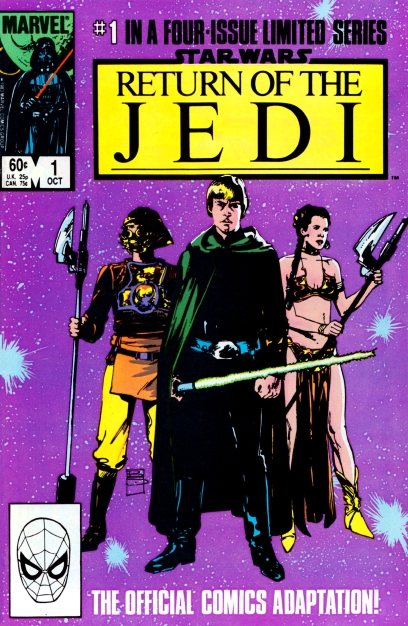 Plot summary Plot summary: High above the forest moon of Endor, an Imperial shuttle approaches a new armoured space station that the Empire is building, which is even more powerful than the first Death Star. As the shuttle docks, Darth Vader disembarks to meet with Commander Jerjerrod and appraise the rate of construction. The commander assures the Dark Lord that the Death Star will be operational on schedule, but Vader warns Jerjerrod that the Emperor himself will soon be visiting the station and that he is displeased with the apparent lack of progress. Visibly shaken by this news, Jerjerrod vows that he and his men will immediately double their efforts. Meanwhile, on the planet Tatooine, Luke Skywalker and Princess Leia have hatched a plan to rescue Han Solo from the gangster Jabba the Hutt. The two droids C-3PO and R2-D2 are dispatched to Jabba's palace in order to deliver a holographic message from Luke, in which the young Jedi offers to bargain with the Hutt for Solo's life. Jabba scoffs at the proposal and puts 3PO to work as his translator, while R2 is forced to become a serving droid on the Hutt's Sail Barge. Shortly afterwards, a mysterious bounty hunter named Boushh arrives at the palace, with a hand-cuffed Chewbacca in tow. Boushh forcefully negotiates a bounty for the Wookiee, and Chewbacca is summarily imprisoned. Later that evening, with Jabba's court now deserted, Boushh approaches the carbon-frozen form of Han and frees him, as the mercenary reveals herself to be Leia in disguise. But before she can escape with Solo, the pair are captured. Solo is thrown into a cell with his Wookiee first mate, while Leia is forced to become Jabba's slave and wear a metal bikini, as Lando Calrissian – who managed to infiltrate the palace earlier and is now disguised as a guard – looks on. Shortly afterwards, Luke gains entry to Jabba's palace and tells the crime lord that he is taking Solo and his friends with him and that it is up to the Hutt whether he wants to profit from this or be destroyed. Jabba refuses to release the Rebels and triggers a trap door beneath Luke's feet, causing the young Jedi to plunge down into a pit, where he is attacked by a towering, ferocious creature known as a Rancor. Luke kills the beast, which enrages Jabba to such a degree that he decides to execute Skywalker, Solo and Chewbacca by feeding them to the Sarlacc – a tentacled maw, with razor-sharp teeth located in the Great Pit of Carkoon, out in the Dune Sea. Comments: So, here we have the long-awaited first instalment of the comic book adaptation of Star Wars: Episode VI – Return of the Jedi. Actually, this issue wasn't the first time that this adaptation appeared because Marvel had already published it in its entirety two months earlier in the paperback-sized The Marvel Comics Illustrated Version of Star Wars: Return of the Jedi and in Marvel Super Special #27: "Return of the Jedi". What this four-part monthly serialisation does offer though is some new opening splash pages and cover artwork by Bill Sienkiewicz, three extra splash pages illustrated by Rick Bryant (in issues #2, #3 and #4), and a host of bonus pin-up illustrations at the back of each issue. Sienkiewicz's covers are pretty uninspiring overall and the garish colour scheme that he chooses for the backgrounds looks rather too '80s for my tastes. By contrast, Sienkiewicz's painted cover for Marvel Super Special #27 is absolutely gorgeous and deserves to be reproduced here in its original state, shorn of any cover blurb or title graphics...  This striking cover painting was also used in the UK for the hardcover Return of the Jedi annual and as the cover of Return of the Jedi Weekly #1. As for the interior artwork, the Jedi adaptation sees the return of artists Al Williamson and Carlos Garzon, who had both worked so successfully on Marvel's version of The Empire Strikes Back. As a rule of thumb, the way in which Williamson and Garzon worked together was that the former would do panel and page layouts, along with the figures and foregrounds, while the latter would do backgrounds and hardware. Both artists would then ink their own work. If you've been following my reviews you'll probably already know that I absolutely adore Williamson's artwork and consider him to be just about the best artist to have worked on Marvel's Star Wars series. His art is highly detailed, with photo-realistic tendencies, but it never sacrifices its inherent comic book qualities either. His locations and characters all have that wonderfully lived-in look, which dovetails nicely into the "used galaxy" aesthetic that George Lucas was striving for in his films. It's actually a bit of a shame that the covers of this mini-series weren't done by Williamson and Garzon too. We get ample example of Williamson's beautiful artwork in this issue, with the artist liberally using his lush shadow work (or spot blacks, to use the correct terminology) in the scenes set within the dimly lit interior of Jabba the Hutt's palace...  In the Art of Al Williamson book, Lucas himself recounted how Williamson insisted on receiving only one chapter at a time of Archie Goodwin's script, while he worked on the adaptation. The reason for this is because the artist wanted to enjoy the story as he was drawing it, in a similar way to how cinema audiences would enjoy watching the film for the first time, wondering what was going to happen next. As with their version of Empire, Williamson and Garzon do a really great job here, with plenty of inventive staging and "camera angels", while the panel-to-panel storytelling is basically flawless. However, I've always felt that the artwork in this adaptation was inferior to that found in the Empire one, although it's hard to explain exactly why. On the surface of things, Williamson's art is as gorgeous and effective as ever, but, I don't know, it feels slightly less inspired somehow. Less dynamic, less imbued with movement – as if it's just a little too reliant on reference photographs from Lucasfilm, rather than Williamson's own creativity and impeccable eye. While we're on the subject of the artwork, I should note that the colouring in this mini-series and Marvel Super Special #27 is different to that which appeared in the paperback-sized The Marvel Comics Illustrated Version of Star Wars: Return of the Jedi. Christie Scheele and Bob Sharen handle the colouring here, but Ken Feduniewicz did the colouring for the paperback. Both colouring jobs compliment Williamson's artwork very nicely, although they are noticeably different to each other. Feduniewicz's colouring is the bolder of the two and definitely 'pops' more on the page, but it lacks the subtly of Scheele and Sharen's work and, to my eyes, puts too much emphasis on the backgrounds at times. Incidentally, both sets of colourist erroneously give Jabba's dancing girl Oola a human skin tone, when she should actually be green. In the comparisons below, Scheele and Sharen's colouring is on the left, while Feduniewicz's work is on the right...   Many of the panels are noticeably cropped in the paperback version too, in order that the dialogue balloons should be legible in the smaller format. As for why Marvel had Feduniewicz colour the paperback-sized version, when they already had Scheele and Sharen doing the other editions, I'm not sure but I'm going to assume that it was something to do with the paper stock used for the paperback requiring a distinctly different palette. I should also make mention of the fact that this adaptation represents the first time that we've see the cinematic version of Jabba in the Marvel comics. Although everybody's favourite intergalactic crime lord had previously appeared in issues #2, #28 and #37 of Star Wars, he had been depicted as a human-sized, bipedal alien, with yellow skin, rather than the bloated, slug-like creature we all know and love. The reason for that, as I explained in my review of Star Wars #2, was because when Howard Chaykin and Steve Leialoha drew issue #2, Lucasfilm hadn't yet decided on a finished design for the Hutt. The two artists therefore based their version on an alien creature seen briefly in the cantina sequence of Star Wars: Episode IV – A New Hope and it was this version of the character that was used for Jabba's subsequent appearances in the comic, prior to The Empire Strikes Back. No attempt is made in the adaptation of Return of the Jedi to reconcile the two markedly different versions of Jabba that Marvel had given us. Would the real Jabba the Hutt please stand up (oh, that's right, he can't!  )... 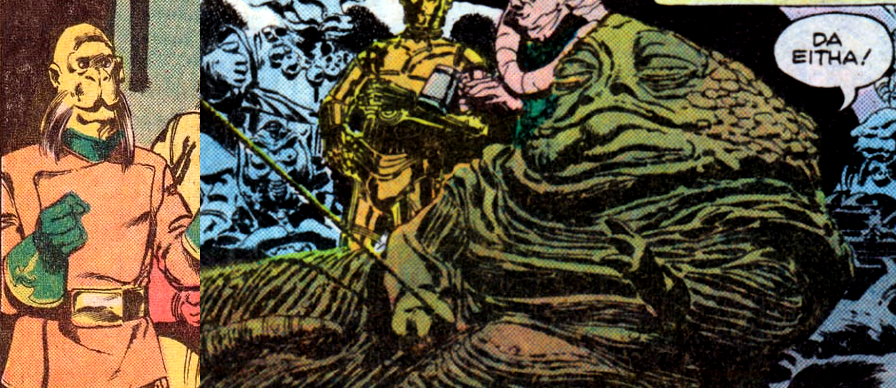 Something else that I just want to make quick mention of is that Williamson designed a new corner cover symbol for this mini-series, using artwork from his cover for Star Wars #39... 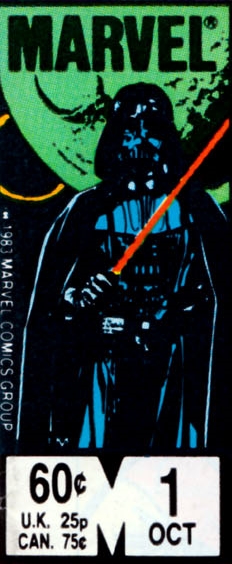 In addition to bringing Williamson and Garzon back, the Return of the Jedi adaptation also sees the return of writer Archie Goodwin to Marvel's Star Wars universe. Goodwin had been the regular writer on Star Wars from 1978 until 1981 and had also scripted Marvel's adaptation of The Empire Strikes Back. Here he does a marvelous job of bringing Lucas and Lawrence Kasdan's screenplay to the comic page and, in particular, his narration boxes give the adaptation a real air of drama. Unlike the Marvel versions of A New Hope and Empire, there are no deleted scenes present in this adaptation, despite their inclusion in the film's shooting script. That observation, together with the fact that Williamson had to enlist the help of a number of fellow artists, including Ron Frenz, Tom Palmer, Dave Stevens, Tom Yeates, William Stout and Bill Sienkiewicz in later chapters, to help him make his deadline, suggests to me that this adaptation was produced in late 1982 and early 1983 – well into post-production and final editing of the movie. This also ties-in with comments made by the former writer on the Star Wars comic, David Michelinie, about having made the decision to leave the book in mid-1982, after realising that he wouldn't be scripting the comic book version of the third Star Wars film. Given this time frame, I have a hunch that Goodwin actually based much of his script on the then-unpublished Return of the Jedi novelization by James Kahn. Maybe Lucasfilm provided Goodwin with a copy of Kahn's manuscript in order to accelerate production of the comic book? Certainly, there are pieces of dialogue in this first chapter of the adaptation – like having Jabba refer to C-3PO as his "talkdroid" and later telling Luke Skywalker that he had been "killing your kind when being a Jedi meant something" – which are not present in the film's shooting script, but are included in Kahn's book. Actually, I think that line about killing Jedi Knights is a really great piece of in-character dialogue and makes Jabba seem a lot nastier and even more threatening than he was in the film. Goodwin also gives us a noticeably different version of the film's signature opening crawl... 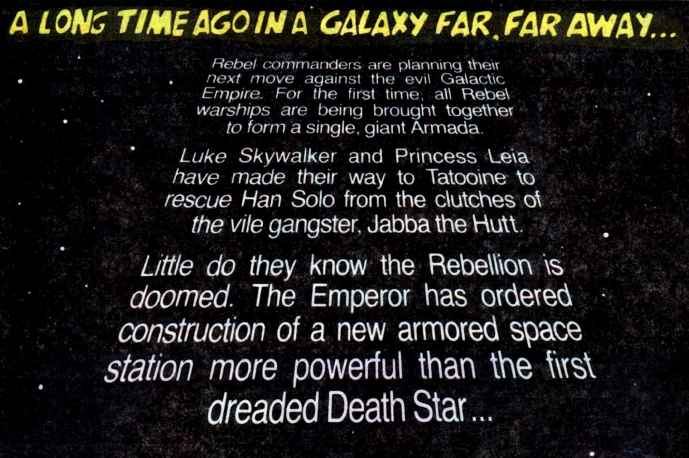 Another very noticeable difference between the two previous Star Wars film adaptations that Marvel had given us and this one, is that Jedi is serialised in four parts, rather than six. This adaptation also wasn't included as a part of the regular ongoing comic series. I've always assumed that Marvel decided to serialise the Jedi adaptation in a separate four issue mini-series as a way to get two Star Wars comics on the shelves each month, as consumer interest in the franchise grew to fever pitch. Of course, that still doesn't explain why Marvel didn't commission a six-part comic adaptation, as they had done for the other Star Wars films, since, in terms of profit, six issues would've earned them more than four. Personally, I think that the most likely reason for the shortened adaptation of Jedi is that Williamson wouldn't commit to drawing any more – let's not forget that he was also drawing the daily Star Wars newspaper strip at this point, which wasn't the case when he did the Empire adaptation. By his own admission, Williamson had never been a particularly fast artist and I think he knew that he wouldn't be able to do all of the work required on time, had the adaptation been extended to six issues. Even keeping it at four issues, Williamson almost missed his deadline and had to bring in additional artists, as I mentioned above. Summing up, this first chapter of Return of the Jedi is as well paced and exciting as its cinematic counterpart. Yes, the artwork is slightly less exciting than Williamson's previous contributions to Marvel's Star Wars series, but still, I'll take slightly substandard Williamson art over pretty much anybody else's, so it's really not a deal breaker. This issue has some very serviceable scripting, some beautiful artwork, and is a very enjoyable comic overall. Continuity issues: - Oola is incorrectly coloured with pink, human-like skin, when she should be green.
- It is hinted in this issue that the Rancor is native to Tatooine, but later expanded universe sources have established that the creature comes from the planet Dathomir.
Favourite panel:  Favourite quote Favourite quote: "Jedi mind tricks will not work on me, boy. I am not affected by your human thought pattern. I was killing your kind when being a Jedi meant something!" – Jabba the Hutt taunts Luke Skywalker about his ability to resist the young Jedi's Force powers. Vader's line about the Emperor not being as forgiving as him (which I’ve always liked) is not here. The art was great, but there were some scenes that I didn’t think were well depicted, such as ." The part where Luke Force takes a gun from Jabba's guard, Luke wedging the bone into the rancor's mouth, and Luke killing the rancor. Perhaps there just weren’t enough pages. 4 issues and 17 pages of story per issue. 64 pages isn’t a lot. I don’t know why they condensed this adaptation so much. That could also explain why, as Confessor noted, there are no deleted scenes here. The art seems to have more dark shadows and muted colors (I’ve got the American back issues) in this adaptation. I also didn’t like the scene with bounty hunter Leia bargaining with Jabba as much here as in the film. |
|
|
|
Post by dbutler69 on Jun 10, 2021 7:23:02 GMT -5
Star Wars: Return of the Jedi #2Cover dated: November 1983 Issue title: The Emperor Commands!Script: Archie Goodwin Artwork: Al Williamson (pencils & inks)/Carlos Garzon (pencils & inks)/Bill Sienkiewicz (pencils & inks – uncredited)/Rick Bryant (pencils & inks - uncredited) Colours: Christie Scheele, Bob Sharen Letters: Ed King Cover art: Bill Sienkiewicz Overall rating: 10 out of 10 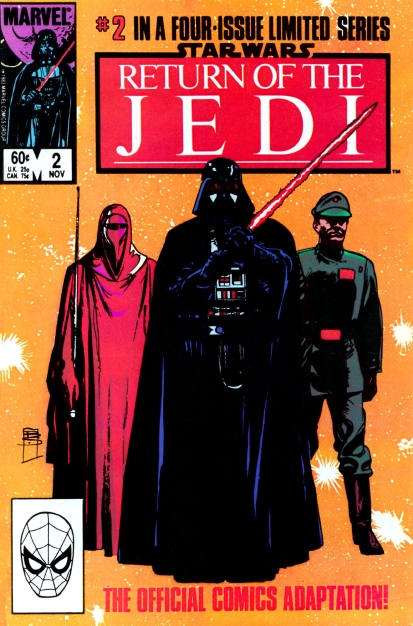 Plot summary Plot summary: Having incurred the wrath of the gangster Jabba the Hutt, Luke Skywalker, Han Solo and Chewbacca are taken to the Dune Sea in a hovering skiff to be fed to the Sarlacc – a tentacled maw, with razor-sharp teeth. With help from R2-D2 and a disguised Lando Calrissian, Luke launches an escape attempt, as a deadly laser blast from Jabba's nearby Sail Barge rocks the skiff, sending Lando tumbling towards the Sarlacc. Luckily, he manages to grab a dangling cable on the underside of the craft to temporarily save himself. Meanwhile, on board the Sail Barge, Princess Leia takes advantage of the sudden confusion and kills Jabba by strangling him with the chain she is tethered to him by. Using the Force, Luke leaps onto the deck of the Sail Barge, hewing down Jabba's men, as the bounty hunter Boba Fett joins the fray on board the skiff. Han attacks Fett, accidentally igniting his jetpack and sending the bounty hunter careening into the Sarlacc's hungry mouth. Back on board the Sail Barge, a well-aimed blaster shot damages Luke's cybernetic right hand, as Leia gains control of the barge's deck gun and, at Luke's urging, turns it on the Sail Barge itself. Han and Chewbacca form a human chain on the skiff to reach down and rescue the dangling Calrissian and the Rebels escape into the desert, as Jabba's barge explodes behind them. As they leave Tatooine, Luke turns his X-wing fighter towards the planet Dagobah, promising to join his friends later. Elsewhere, on the partially completed Death Star, Emperor Palpatine arrives to personally oversee the final stages of the battle station's construction. Sensing that Darth Vader wishes to continue his search for Luke, the Emperor assures the Dark Lord that, in time, Skywalker will seek him out and when he does, they will turn Luke to the dark side of the Force together. Palpatine also commands that the Imperial fleet be sent to the far side of the nearby planet Endor, where it will wait to take part in the final destruction of the Rebel Alliance. Meanwhile, having arrived back on Dagobah to complete his Jedi training, Luke finds that Yoda has fallen ill. The ancient Jedi Master tells Skywalker that he must face Vader once again, prompting Luke to ask if Vader is indeed his father, as the Dark Lord has claimed. Yoda confesses that this is so, confirming Luke's worst fears. Leaving Yoda to rest, Luke wanders back to his X-wing, as a ghostly vision of Obi-Wan Kenobi appears. Kenobi explains that Vader was originally named Anakin Skywalker and that, due to his failure as a teacher, the Emperor was able to lure Anakin to the dark side. Luke tells Obi-Wan that he has sensed some good still remaining inside of Vader, but Kenobi disagrees, stating that he is more machine than man and that no part of Anakin's goodness remains. Kenobi also reveals to a stunned Luke that Leia is in fact his twin sister and that they were separated at birth, with Leia being raised by the royal family of Alderaan, while he grew up on Tatooine. Comments: This second chapter of the comic book adaptation of Return of the Jedi is probably the best, given that there's plenty of exciting action, some absolutely jaw-dropping revelations, and the first appearance in the Marvel comics of the long-talked-about, but never-before-seen Emporer. In addition, this chapter probably has the best artwork, with artists Al Williamson and Carlos Garzon still very much on top of their game at this point and not yet having been overwhelmed by their workload or a looming deadline, as they were in following instalments. As ever with Williamson, the artwork here is simply gorgeous. You get that signature bold use of shadow, the authentically lived-in aesthetic, and plenty of dynamic movement in the art – especially in the action sequences showing Luke taking on Jabba's men on board the Sail Barge. In fact, the scenes with Luke battling Jabba's men are arguably more kinetic under Williamson's hand than they were in the film. In particular, this three-panel sequence, which also includes my favourite panel of the issue (see below), is absolutely fantastic...  Another thing about Williamson's art is that he always draws beautiful women and his Princess Leia looks every bit as good in a gold bikini as Carrie Fisher did.  Actually, while we're on the subject of Leia, writer Archie Goodwin has her take out the deck gunner on board the Sail Barge with a discarded spear, whereas in the film Luke does it with his lightsaber. Goodwin also inserts a nice little cliffhanger moment, in which, just after she's killed Jabba the Hutt, a sinister shadow falls across the princess's face as her deed is discovered. Ultimately, it turns out to be nothing more than R2-D2 arriving to free the princess from her bondage, but it's a nice additional moment of peril during the Sarlacc scene that's sadly missing from the film. On a related note, I've always felt that Jabba's death is somewhat underplayed in the comic. It's all over in two panels and seems rather anti-climactic to me. It's definitely a lot more satisfying in the movie. Although Goodwin – courtesy of Lawrence Kasdan and George Lucas's screenplay – gives us some pretty significant revelations in this issue, such as confirming that Darth Vader is Luke's farther and revealing that Leia is Luke's twin sister, Yoda's death is unfortunately absent. The scene in which the ancient Jedi Master dies is entirely skipped over: we see Yoda telling Luke, "When gone am I … last of the Jedi will you be", and then the narration explains that Skywalker "leaves Yoda to much-needed rest." I've speculated before in this thread about why such an important scene might've been omitted and I don't believe it was due to the adaptation's shortened length (the two previous Star Wars film adaptations had been six issues long, whereas Jedi was only four). While it's certainly true that space would've been a concern, this is such an important scene that surely Williamson could've squeezed in a couple of panels dealing with it somehow? No, I think, given that Lucasfilm had instructed Williamson to not show the Wampa or the giant space slug in his adaptation of The Empire Strikes Back – so as not to spoil the surprise for cinema audiences – the reason that Yoda's death scene was omitted was due to their request, rather than because of a lack of space. Something that this comic has in common with all the issues of this mini-series is that it features a new title splash page by an uncredited Bill Sienkiewicz, which hadn't appeared in any of the earlier versions of the adaptation (like the one published in Marvel Super Special #27, for instance). There's also another exclusive splash page in this issue of Luke battling Jabba's men by an uncredited Rick Bryant. It's a shame that this page couldn't have been drawn by Williamson because it's inserted directly into the adaptation, between two of his pages, as if it had always been there. Here's Bryant's page, in case you're interested... 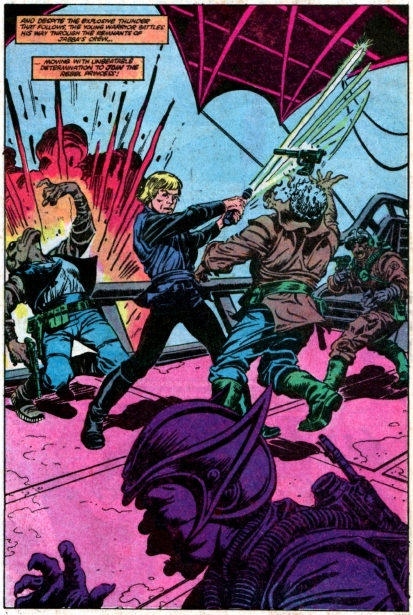 It's not like it's a terrible piece of art or anything and, actually, Bryant does a reasonable job of aping Williamson's style, but unfortunately it adds nothing to the overall narrative and the sudden change in artist is both noticeable and jarring. Bryant would also contribute new, in-story splash pages like this to Star Wars: Return of the Jedi #3 and #4. As for why these were needed, I can only guess that it was in order to provide a unique selling point for the mini-series to those who had already bought one of the earlier editions of the adaptation. There are also three pin-up posters by Bryant at the back of this issue, along with one by Paul Becton and Marie Severin. All in all, this is a cracking comic. It's very faithful to the movie that it adapts and, on occasion, it even scores over the film in one or two tiny respects. Yes, I could've done without the Rick Bryant splash page that is clumsily inserted into the narrative and, yes, the absence of Yoda's death scene is a regrettable omission, but the beauty, emotion and sheer zip of Williamson's artwork, along with the thrilling momentum of this portion of story make for a gripping read. As such, I've no choice but to award this comic top marks, despite the criticisms I have. Continuity issues: - It's Princess Leia who defeats the deck gunner on board Jabba's Sail Barge here and not Luke Skywalker, as it is in the movie.
Favourite panel:  Favourite quote Favourite quote: "That carbon freeze was pretty close to bein' dead. Now comin' back … well, my eyes aren't the only things seeing different, buddy." – Han Solo attempts to articulate to Luke Skywalker how his time encased in carbonite has effected his view of their friendship and his role in the Rebellion. Lando is the original owner of the Falcon? I’d always assumed that someone owned the Falcon before Lando, and perhaps he conned them out of it. There was some nice dialogue from Han after his rescue about seeing things differently after being carbon frozen. I don’t know if that was in a deleted scene or if Goodwin came up with it. The scene where Yoda says he’s dying and Luke says he can’t, in the comic Yoda says strong with the Force you (meaning Luke) are. I think Yoda should be saying that he (Yoda) isn't that strong with the Force, not Luke. Yoda says here it was he that told Ben not to tell Luke the truth about his father. Interesting. They didn’t show Yoda’s death, for some reason. Confessor’s theory as to why makes as much sense as any. I suppose, but it still isn’t very satisfactory. Ben says he met Annakin during the Clone Wars, which contradicts the prequels, of course. Also, Ben tells Luke that Leia is his sister here, instead of Luke sensing it, as in the film. |
|
|
|
Post by wildfire2099 on Jun 10, 2021 8:23:17 GMT -5
Gonna be a bit before I can read those (Epic out in July I think? got it on reserve with my LCS), but just a quick comment.. droids in the Star Wars universe definitely don't just follow orders... R2 argues with people all the time... like people, some are more rule-followery than others.
In fact, even restraining bolts don't brain-wash them or anything, just restrict how far away they can go.
|
|
|
|
Post by badwolf on Jun 10, 2021 10:09:03 GMT -5
Star Wars #46Cover dated: April 1981 Issue title: The Dreams of Cody Sunn-Childe!Script: J. M. DeMatteis (credited under the pseudonym of Wally Lombego) Artwork: Carmine Infantino (pencils)/Tom Palmer (inks) Colours: Glynis Wein Letters: Diana Albers Cover art: Ed Hannigan (pencils)/Tom Palmer (inks) Overall rating: 9 out of 10 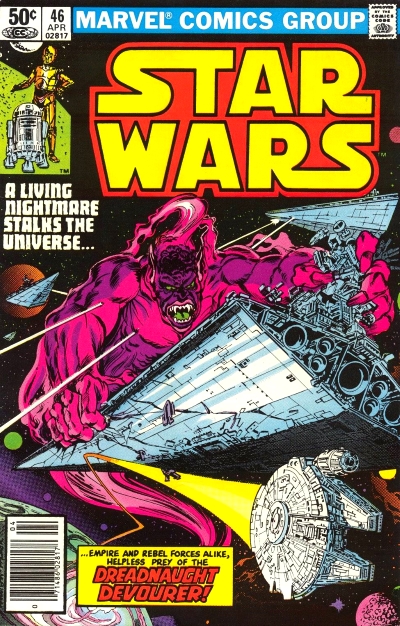 Plot summary Plot summary: While searching the space ways for their friend Han Solo, Lando Calrissian and Chewbacca have a mechanical problem with the Millennium Falcon's engines, which throws the freighter off into another dimension. Coming upon a mysterious floating city, the pair land and soon come face to face with the long lost Rebel hero Cody Sunn-Childe. The near-legendary warrior explains that after gaining powerful mystic abilities he turned his back on the violence of his past and created a floating "City of Dreams" using his psychic powers. Sunn-Childe tells the pair that he is now content to live with his friends in peace, far away from the violence of the Empire and the Galactic Civil War. Lando rejects Sunn-Childe's philosophy, arguing that sometimes violence is necessary in order to combat great evil. Appalled by what he perceives as Cody's cowardice, Lando readies the Falcon for take off, just as a fleet of Imperial Star Destroyers launch an attack on the floating city, having found an opening in the space-time continuum leading to the alternate dimension. As Lando and Chewbacca blast off and engage the Imperials in battle, Cody gives in to his warrior instincts and unleashes a horde of psychic demons that attack the Star Destroyers. However, the one-time freedom fighter suddenly comes to his senses and decides to hold true to his pacifist ideals, allowing himself and his beloved city to be destroyed. Surveying the shattered remnants of Sunn-Childe's paradise-like retreat, Lando tearfully concludes that the former Rebel was wrong to believe that his pacifist ideals would lead him along the right path when dealing with the Empire. Turning the Falcon towards a rapidly closing rent in the fabric of space that leads back to their own galaxy, Lando and Chewbacca leave the Imperial fleet imprisoned in this strange dimension as part of what Lando calls "Sunn-Childe's revenge." Comments: The first thing to say about issue #46 of Star Wars is how much better Carmine Infantino's artwork looks here, when compared to the previous issues that he'd drawn. We know from comments that writer and comic historian Glenn Greenberg posted a few days back in this thread that the book's new editor, Louise Jones, had decided to make a concerted effort to have the comic be more visually faithful to the movies – and there's ample evidence of that here! Pairing Infantino with a strong and highly detailed inker like Tom Palmer serves to smooth out all those annoyingly over-angular tendencies that I've moaned about time and time again during these reviews. As is often the case with Palmer's inking, he very much puts his own stamp on the finished art, while simultaneously still managing to be sensitive to the artist's pencilling. That being said, on occasion it's kind of hard to see Infantino's influence at all in some of the artwork in this comic and, as a result, I definitely suspect that parts of this issue were completely redrawn by Palmer. For example, in some of the panels in which appear, the fleet of Imperial Star Destroyers look very much like Infantino's work... 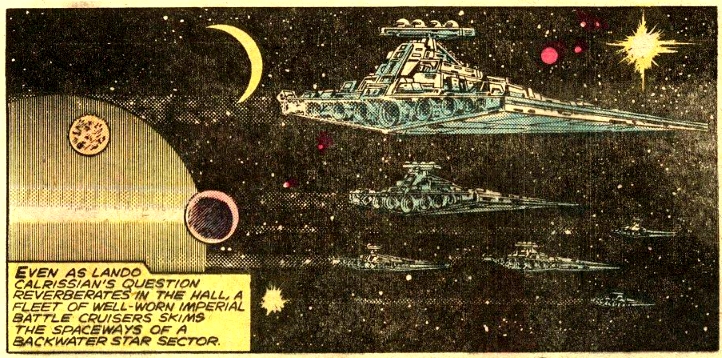 While in others, the Empire's warships look a little too much like they did in the Star Wars films for them to be based on Infantino's pencils, I feel...  Still, for the majority of the time, Infantino's signature style is clearly discernible. In addition, the staging, the "camera angles" chosen and the sheer clarity and fluidity of the storytelling very much have Infantino's mark on them. What Palmer brings to the table is making this issue actually look like it's set in the cinematic Star Wars universe. Indeed, based on this issue, I kinda wish that Palmer had been brought in to ink Infantino much, much earlier – say, from issue #18 onwards, when Bob Wiacek and Gene Day came on board as the series' regular inkers. Palmer really does elevate the artwork here to a level that we've rarely seen in the series. This is hardly surprising though: like I said in my review of Star Wars #8, I long ago realised that when it comes to comic books, everything's better with added Tom Palmer! Star Wars #46 was the first and only issue to be written by John Marc DeMatteis (more usually known as plain ol' J. M. DeMatteis), although he's credited as Wally Lombego here. DeMatteis was relatively new to Marvel at the time, having only recently begun working as a writer on The Defenders, though he would later go on to write such high profile titles as The Amazing Spider-Man and Justice League International for Marvel and DC respectively (as well as penning the celebrated Spider-Man classic "Kraven's Last Hunt"). The reason for the pseudonym was because DeMatteis became infuriated by editorial changes that were forced upon his story by Lucasfilm and he decided that he no longer wished to be associated with it. DeMatteis takes up the story himself in this edited excerpt from a 2010 post on his personal blog... "I got to work crafting a tale about Lando Calrissian and his encounter with a legendary rebel fighter, of my own creation, named Cody Sunn-Childe. Note the name, please: Cody Sunn-Childe. You see, my son Cody was born right around the time I got the assignment and, y'know, he's my son. And my child.
I thought it would be an interesting touch to have Cody Sunn-Childe, this great warrior that Lando Calrissian idolized, go through a spiritual transformation and become a pacifist. In the end, although an attack by the Empire tempts Sunn-Childe to return to his old ways, he decides that it's better to allow himself to be killed, to die for a dream of peace, than to go down fighting. Keep in mind that I didn't belittle the Star Wars characters, or their beliefs, in any way: I was just presenting another point of view while keeping Calrissian and company true to their roots. They had their views, Sunn-Childe had his: let the readers decide who, if anyone, was right. "The Dreams of Cody Sunn-Childe" wasn't a brilliant piece of work by any means, but I think it had something of value to say. And it was a "something" I wanted to pass on to my newborn son – which is why I named that new character after him.
The book went off to the Lucasfilm reps for approval. They weren't happy. It seemed that, to them, the very idea that a character in the Star Wars universe would voice an opinion that in any way contradicted the Skywalker Worldview was offensive. The word came down that Sunn-Childe, in rejecting violence, made their characters look bad.
Marvel had to keep the Lucas people happy: new dialogue was written for the last page – not by me! – and I’ll never forget this line that was added: "He died for his dream of peace," Calrissian said, "but he was wrong." No maybes about it: Cody Sunn-Childe was an idiot who sacrificed his life for nothing.
To me, the Lucas people were the ones who were wrong; so wrong, in fact, that I took my name off the story, replacing it with the admittedly, and intentionally, ridiculous nom de plume Wally Lombego."So there you have it! Well, almost...because what DeMatteis may not have known is that over here in the UK, his story was published in its unaltered form and with his real name listed in the credits! Below is a scan of that heavily edited final page of Star Wars #46, which so upset its author, followed by a scan of the same page as it appeared in Marvel UK's The Empire Strikes Back Monthly #141. The latter version is how DeMatteis originally intended for his story to end...   Of the two endings, I find it hard to decide which one I actually prefer. DeMatteis's unaltered ending definitely fits the tone of the tale better and I like that Lando actually learns something of Sunn-Childe's philosophy at the story's conclusion. However, I also liked the revenge angle of Lando just leaving the Imperials trapped in that other dimension to rot. That felt very in character to me and I liked seeing them get their just deserts, with Lando's actions providing an interesting juxtaposition to Sunn-Childe's. I think ultimately it's a pity that DeMattis's original ending couldn't have included Lando leaving the Imperials trapped, while still having him realise that Cody's course of action was a noble one and not wrong. Leaving behind the controversy about this issue's ending for a moment, it's really cool to see Lando and Chewbacca in an adventure together for the first time. In Lando's case, this is the first time that we've seen this newest addition to the central cast in a story outside of the Star Wars films. To his credit, DeMatteis gets Lando's character pretty much spot on straight away. He also writes an interesting dynamic between Lando and the Wookiee, with it being pretty obvious that Chewbacca still doesn't wholly trust his partner and, considering recent events in The Empire Strikes Back, that's very understandable. On the downside, there's possibly a slight continuity problem here when Lando states that he saw Sunn-Childe in action against the Empire as a boy. Lando is in his mid-30s and we know from the prequel trilogy that the Empire didn't replace the Old Republic until 18 years before Star Wars: Episode IV – A New Hope. That means that even if Lando saw Sunn-Childe resisting the Empire very soon after the events of Star Wars: Episode III – Revenge of the Sith, he would've still been 14 or 15 at the time. That's not really a boy, more like a young adult. Still, I'm gonna let this one slide because I guess that a 15-year-old could still legitimately be termed "a boy." My suspicion though is that DeMatteis really meant for Lando to be much younger than that, but subsequent revelations in Star Wars continuity have made that impossible. Another complaint about this issue would be that, during the battle against the Imperials, Lando seems to be ramming the Millennium Falcon against the edges of the attacking Star Destroyers. Surely that would cause a lot of damage to the Corellian freighter? Maybe the Falcon's shields were up full or something, thus preventing the ship from sustaining any damage itself. Still, it seems like an odd way to do battle. Overall, this is an interesting and very thought-provoking issue. The fact that Cody believes that it's more important to stay true to his beliefs and die, than it is to give in to violence and survive, makes this a morally complex story. As such, it blows a great big raspberry at those who would dismiss the old Marvel series as being childish or unsophisticated. This is heavy, mature, philosophical stuff. That said, Star Wars #46 still has enough action in it to thrill fans of space opera and I certainly liked this issue a whole lot as a kid. I read and re-read this story until my copy almost fell apart and today I get a warm, fuzzy glow of nostalgia from revisiting it, which will ultimately cloud my judgement when it comes to rating this comic. It's a pity about the editorially mandated ending in the U.S. comic, but being a Brit, the way the story ended for me is exactly the way that DeMattis intended. Either way though, I consider this to be a really top draw entry in Marvel's Star Wars series. Continuity issues: None. Favourite panel: 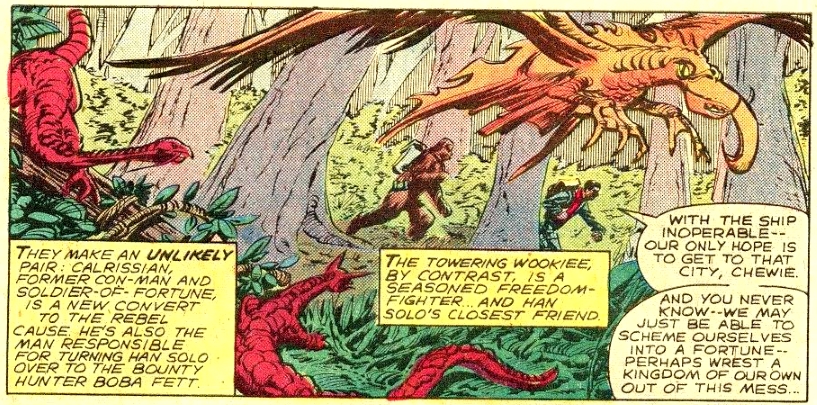 Favourite quote Favourite quote: "Your truth is not my truth." – Cody Sunn-Childe cryptically espouses his non-violent philosophy to Lando Calrissian. I had to jump back and check your review on this issue and I'm glad I did. I didn't have a lot of SW comics as a kid -- a handful of early issues, a few parts of ESB, the ROTJ miniseries, and, seemingly randomly, this one -- and I always like it a lot, even though I may not have been conscious of why as a kid.
I did not know that Wally was J.M.! But it makes sense. Spiritual and philosophical themes are a hallmark of his work. The information about the ending is interesting; most of Lando's monologue is okay, but that "he was wrong!" always seemed jarring and not quite right to me, even when I was young. I'm happy to see that my feelings aligned with the author's. I do like the revenge bit as well. Thanks for researching and quoting that section from J.M.'s blog!
I too think that this is some of Infantino's best work.
|
|
|
|
Post by tarkintino on Jun 10, 2021 13:55:19 GMT -5
I know droids in the Star Wars Universe often do appear to show emotion (such as Threepio often acting scared - though that could basically be self-preservation programming) but I felt that this went a bit too far. Also, the scene towards the beginning where quite a few stormtroopers marched in on Luke & Leia, our heroes took out those stormtroopers too easily. Threepio "crying" was an example of Duffy tossing the structure and film-established nature of characters for emotionalism that SW fans know is impossible for a droid. He's not Thomas' Vision. His "emotional" beat have been---in the films--fear and concern. That's it, and that would be maintained in ROTJ, which takes place after this issue. |
|
|
|
Post by tarkintino on Jun 10, 2021 14:34:09 GMT -5
Marvel's Return of the Jedi adaptation (published between October 1983 - January 1984) was published long after the movie was already out of theaters, and Star Wars as a cultural event was fading, since the general public had been informed--at the time-that ROTJ was the end of the Star Wars "saga". For that reason, Marvel's adaptation was a ho-hum affair, and its numerous problems--from Williamson not completing some of the pages, to coloring issues--marred the effect of the adaptation. As noted before, this panel--  --instantly takes this out of continuity with the monthly title, as Luke having another Lightsaber is presented as a surprise (as in the film), after the events of TESB, so this major continuity issue effectively takes it out of the monthly's "world". That, and a few issues before the publication of ROTJ, the monthly had Frenz suddenly illustrate the Lightsaber hilt to appear like the ROTJ version--  --which also made no sense, as Luke changed it from that blue-bladed, quasi-ANH/TESB styled hilt for what reason...? Without a doubt, the best creative output from Marvel's ROTJ adaptation was Bill Sienkiewicz's cover for Marvel Comics Super Special #27 (September, 1983)--  --which was so conceptually advanced over the interiors, and took on the appearance of an alternate "A" sheet for the film. Too bad he was not hired to produce one of the film's posters, because it was so in line with the message and drama of the film. |
|
|
|
Post by dbutler69 on Jun 10, 2021 16:02:19 GMT -5
I'm not a Bill Sienkiewicz fan, but he did do some fantastic covers for Return of the Jedi.
|
|
|
|
Post by dbutler69 on Jun 11, 2021 14:08:35 GMT -5
Star Wars: Return of the Jedi #3Cover dated: December 1983 Issue title: Mission to Endor!Script: Archie Goodwin Artwork: Al Williamson (pencils & inks)/Carlos Garzon (pencils & inks)/William Stout (pencils & inks – uncredited)/Dave Stevens (inks – uncredited)/Tom Yeates (inks – uncredited)/Rick Bryant (pencils & inks – uncredited)/Bill Sienkiewicz (pencils & inks – uncredited) Colours: Christie Scheele, Bob Sharen Letters: Ed King Cover art: Bill Sienkiewicz Overall rating: 7½ out of 10  Plot summary Plot summary: On board a command ship amid the Rebel fleet, a gathering of top ranking Alliance leaders, including Han Solo, Princess Leia, Luke Skywalker, and Lando Calrissian, learn that the Empire has constructed a new Death Star and that Emperor Palpatine himself is overseeing its completion. The Rebel's attack plan comprises of Han leading a strike team in a stolen Imperial shuttle to the forest moon of Endor to deactivate the shield generator which protects the incomplete battle station. After the shield is knocked out, Lando will lead the fighter assault in the Millennium Falcon and attempt to fly into the Death Star's superstructure and destroy its main reactor, which will, in turn, destroy the battle station. During the strike team's approach to Endor, Luke senses that Darth Vader is on board the Super Star Destroyer Executor and the Dark Lord also senses Skywalker's presence. Nonetheless, the shuttle craft makes it through the Imperial blockade and lands on the forest moon. A short while later, the team encounter a unit of Imperial biker scouts and, following an unsuccessful attempt to disarm them by Han and Chewie, Luke and Leia are forced to pursue the scouts through the treacherous forest terrain on fast moving speeder bikes. During the chase, Leia's bike is destroyed and she is knocked unconscious. Upon returning to the strike team, Luke realises that the princess is missing and sets out with Han, Chewbacca and the droids to locate her. Meanwhile, on board the Death Star, Vader informs Palpatine that he has felt Luke's presence through the Force and that he is with a small band of Rebels on Endor. The Emperor instructs Vader to travel to the forest moon and wait for Luke, who he has foreseen will seek him out, and then bring the young Jedi before him. Back on Endor, Luke, Han, Chewbacca and the droids find Leia's wrecked speeder bike, but there is no trace of the princess. As they continue to search, Chewie accidentally springs a trap and the group is captured by a tribe of small furry creatures called Ewoks, who are indigenous to Endor. After being taken back to the Ewok's treetop village as prisoners, the Rebels are reunited with Leia, who has befriended a young Ewok named Wicket. The primitive tribe are coerced into releasing the Rebels and soon they agree to join in the fight against the Empire. Later that evening, Luke tells a shocked Leia that she is his lost twin sister and that Vader is their father. He also tells her that Vader is on Endor and that he must confront the Dark Lord in order to turn him back to the Light Side of the Force. Leia urges her brother not to risk his life and to flee, but Luke insists that he has sensed some goodness still alive within Vader and that he must try to turn him back from the Dark Side. Some time later, Luke surrenders to the Imperial forces and is brought before Vader, who, seeing that he has constructed a new lightsaber, concludes that his son is as powerful a Jedi as the Emperor has foreseen. Luke pleads with his father to go with him and turn his back on the Emperor, but Vader is insistent that he cannot be saved and that Luke doesn't understand the power of the Dark Side. Comments: The comic book version of Return of the Jedi continues with another serviceable instalment, although I'd have to say that this issue is less successful at adapting the film than the preceding two. Archie Goodwin still translates George Lucas and Lawrence Kasdan's screenplay pretty well, but there are definitely some weird omissions. For example, we never actually see Princess Leia's speeder bike crash, and the scene in which Leia meets Wicket the Ewok is also strangely absent. However, unlike not showing Yoda's death in the last issue, I don't think that these scenes were left out in order to prevent the cinema audience from being spoiled; I think they were left out due to the lack of available space (the adaptations of Star Wars and The Empire Strikes Back had both been six issues long, whereas Return of the jedi is only four). In addition, Goodwin seems to choose a pretty weak place for this chapter to finish. I mean, Luke Skywalker has just surrendered to Darth Vader and learned that the Dark Lord will not turn away from the Dark Side or the Emperor, but it's hardly the most thrilling cliffhanger imaginable. Also, some of the humour present in the movie falls a little flat in this issue. At least some of the blame for that must be laid at artist Al Williamson's door. The art doesn't always gel that successfully with Goodwin's writing and, as a result, there are times when parts of the script aren't delivered in the impeccable way that they usually are when these two comic book greats work together. Also, the speeder bike chase – which is such an exciting sequence in the film – doesn't really translate all that well on to the page. There's a lack of movement in the artwork, which is sorely missed in such an exhilarating and kinetic portion of the story. This sequence also feels somewhat clumsily rendered, in terms of the composition of each panel, while the aforementioned absence of Leia's speeder bike crash and subsequent encounter with Wicket only adds to the sense of unfulfilled potential in this part of the adaptation. All this is extremely unusual for Williamson, who is normally so good at punching home Goodwin's scripting and dialogue. The truth is that, unfortunately, by the time of this third chapter, Williamson and his assistant Carlos Garzon were starting to fall behind schedule and were having to rush in order to get the job completed. For that reason, other artistic talents were called upon to help the pair get the adaptation finished on time, as can be seen from the number of uncredited artists listed for this issue. Though the majority of this chapter is still drawn by Williamson and Garzon, we get a brand new splash page of Han Solo punching a biker scout trooper by Rick Bryant that is directly inserted into the story between two of Williamson's pages, which is more than a little jarring. We also get an exclusive opening credits page by cover artist Bill Sienkiewicz. In addition to this, renowned fantasy artist William Stout pencilled and inked over Williamson's rough layouts on a couple of pages, the second of which is reproduced here...  If you're familiar with Stout's artwork, you can spot his hand on these pages fairly easily. I must say that, although Stout's work looks noticeably different to Williamson and Garzon's and is therefore a little jarring, I do rather like these pages. His crisp, detailed inking has a certain organic quality to it that is a particularly good fit for the scenes in the primitive Ewok village. Artist Dave Stevens (of Rocketeer fame) also contributes his inking skills to this issue, on the two pages immediately following the one of Stout's pictured above. Stevens had also helped out with the inking of the final instalment of Marvel's comic adaptation of Star Wars: Episode IV – A New Hope back in 1977 and he was uncredited in that instance as well. Here's the first of his two pages...  I think Stevens' style sits a lot better with Williamson's than Stout's does. His precise lines, inventive Zip-a-Tone shading and lush shadow work look really pleasing here. Tom Yeates also inks some of Williamson's pencils immediately following Stevens's pages and his lush inking technique helps to make the emotionally charged scene in which Luke tells Leia the truth about their shared lineage really hit home. While we're on the subject of the art, I should also note that there's a colouring mistake by Christie Scheele and Bob Sharen in this issue, in which Luke's lightsaber is coloured red instead of green when Darth Vader ignites it on the final page. I'm guessing that the colourists weren't paying attention and assumed that, since Vader was holding the weapon, it must be his lightsaber. Interestingly, Ken Feduniewicz also made the exact same mistake in his colouring of the paperback-sized The Marvel Comics Illustrated Version of Star Wars: Return of the Jedi. Overall, this issue sees Return of the Jedi begin to build to its exciting climax, but is somewhat marred by the jarring presence of guest artists and Williamson's own work not quite gelling with Goodwin's script as well as usual. Continuity issues: - The blade of Luke Skywalker's lightsaber is mistakenly coloured red instead of green when Darth Vader ignites it.
Favourite panel:  Favourite quote Favourite quote: "I don't know, Leia. Looking at the Millennium Falcon back there, I got a funny feeling, like … like I'm not going to see her again." – Han Solo confesses his fears about whether or not his beloved ship will survive the upcoming assault on the Death Star. I agree with Confessor that this adaptation isn’t as good as the previous two, and also that the ending here is weak. And again, the shorted length of this adaptation leads to more missing scenes, as the part where Leia meets Wicket and they take down the stormtrooper together then go off to his village is totally skipped, as well as the conversation between Leia and Han, were Han gets bent out of shape because Leia won’t tell him what she and Luke had just talked about. The splash pages at the end of each issue are very nice, but I’d much rather have had those pages contain story instead of just artwork. I think the shortened nature of this adaptation is responsible for most of the problems. |
|
|
|
Post by dbutler69 on Jun 11, 2021 14:18:00 GMT -5
Star Wars: Return of the Jedi #4Cover dated: January 1984 Issue title: The Final Duel!Script: Archie Goodwin Artwork: Al Williamson (pencils & inks)/Carlos Garzon (pencils & inks)/Ronald Frenz (pencils)/Tom Palmer (inks)/Bill Sienkiewicz (pencils & inks – uncredited)/Tom Yeates (inks – uncredited)/Dan Green (inks – uncredited)/Rick Bryant (pencils & inks – uncredited)/ Colours: Christie Scheele, Bob Sharen Letters: Ed King Cover art: Bill Sienkiewicz Overall rating: 6½ out of 10  Plot summary Plot summary: On board the Millennium Falcon, Lando Calrissian prepares to lead the Rebel fleet against the second Death Star, while his friends and fellow Rebels, Han Solo, Princess Leia, Chewbacca and the droids R2-D2 and C-3PO break into the Imperial shield generator's command bunker on the forest moon of Endor. Elsewhere, Luke Skywalker has surrendered to his father Darth Vader and been transported to the Death Star, where he is brought before Emperor Palpatine, who tells the young Jedi that he has laid a trap for the Rebellion. The Emperor explains that it was he who allowed the Rebel spies to obtain information about the Empire's new battle station, as part of a plan to bring the Rebel fleet out into the open where it could be destroyed in one fell swoop. As the Rebel fleet approaches the Death Star, Calrissian realises that their instruments are being jammed by the battle station and concludes that the Empire must be expecting the attack and therefore the station's protective energy shield is likely still up. As the Rebels advance, the Imperial fleet appears from behind the forest moon to cut off their escape route. Suddenly, a blast from the Death Star's fully operational laser cannon destroys a Rebel frigate. Back on Endor, the Rebel strike team led by Solo is overwhelmed by Imperial troops and captured. As they are led outside the bunker, the Rebel's Ewok allies launch a surprise attack, which leads to a full scale ground battle between the Empire and the primitive creatures, with the Ewok's stone-age weaponry proving surprisingly effective against the Imperial war machine. Meanwhile, in an attempt to lure Luke to the Dark Side of the Force, Palpatine taunts the young Jedi until he ignites his lightsaber and lashes out at the Emperor in anger, only to be prevented from slaying the Sith Lord by Vader's own lightsaber blade. As father and son engage in a duel, Palpatine urges Luke to give in to his anger and embrace the Dark Side. During a lull in the combat, Vader reads Luke's thoughts and discerns that he has a twin sister, who he suggests might be turned to the Dark Side instead. This causes Luke to give into his rage and launch into a frenzied attack, severing Vader's hand and knocking him to the floor. The Emperor urges Luke to kill his father and take his place, but the young Rebel refuses, declaring himself a Jedi, like his father before him. The Emperor realises that Skywalker cannot be turned and unleashes a storm of Force lightning from his fingertips, as Luke writhes in agony. Unable to watch his son being murdered, Vader grabs Palpatine and hurls him down a reactor shaft to his death. Back on Endor, Han manages to trick his way into the command bunker, setting off explosives that destroy the installation and knock out the Death Star's protective shield. Lando seizes this opportunity and leads Wedge Antilles and his group of Rebel fighter craft into the interior of the half-completed Death Star, where they destroy the battle station's main reactor. On board the doomed station, Luke tends to his dying father, unmasking him at his own request, so that he may look upon his son with his own eyes, even though it will kill him. As Vader dies, Luke takes his father's body and escapes the Death Star in an Imperial shuttle, while the Millennium Falcon and the other Rebel fighter craft also escape the station, just ahead of its destruction in a huge explosion. Later that evening on Endor, the Ewoks and Rebels throw a huge party to celebrate the end of the Empire. Comments: So, here we have the final instalment of the comic adaptation of Return of the Jedi and the first thing that jumps out at you is just what a horrible, vomit-inducing colour the front cover is! I've mentioned before that I find Bill Sienkiewicz's covers for this mini-series to be uninspiring and garish, but this issue is by far the most horrible looking of all. Interestingly, there's what looks to be a rejected cover design for this issue reproduced as a bonus pin-up in the back of the book. I definitely prefer this unused cover of Sienkiewicz's to the one that Marvel ultimately went with. Take a look and judge for yourself...  I guess that, ultimately, Luke, Vader and the Emperor are more dynamic characters than Obi-Wan Kenobi, Yoda and Anakin Skywalker, and so Marvel would definitely want the former group jumping out at young comic buyers as they browsed the news stands. But still, I think the rejected cover is the more aesthetically pleasing of the two. Artists Al Williamson and Carlos Garzon turn in some really lovely pages in this issue – in particular, there's a wonderful opening splash page of the Rebel Fleet preparing to go up against the second Death Star – but the deadline pressure that they found themselves under last issue only intensified with this chapter. That pressure necessitated a number of other artists coming in to lend them a hand. Take a look at the art credits above and you'll see just how many other artists pitched in to get this chapter finished on time. Unfortunately, this hodgepodge of artistic talent gives the comic a rather uneven and disjointed feel. Now, before I get into exactly who did what in this issue, let me just say that, although I know for a fact that all of the artists listed above helped out on this issue, a lot of what I'm going to say about exactly what they all did is based on educated guess work. Having gotten that disclaimer out of the way, I can say with the utmost certainty that Sienkiewicz himself drew and inked pages 11, 15, 16 and 17 of this issue, which features the ground battle between the Empire and the Ewoks, the assault on the Death Star's main reactor and the unmasking of Darth Vader. Rick Bryant again contributes a full-page splash that is exclusive to this issue and is inserted directly into the story between Williamson's pages, and this is located on the 7th page of this issue. The original artwork for page 18 (which is the final page of the adaptation) is up on the comicartfans.com website and it clearly credits Dan Green as the inker, over Williamson's pencils, so we can be 100% sure of that. However, I'm less certain about which other pages Green inked, but I'm gonna take a guess and say that it looks to my eyes as if he also worked on pages 8 and 13, which show the Ewoks first attacking the stormtroopers and Luke severing Vader's hand respectively. Tom Yeates also inked some of Williamson's pencils and I'm gonna say that he likely worked on pages 9 and 10 of this chapter, in which Luke Skywalker and Darth Vader duel in the Emperor's throne room. It also kind of looks to my eyes as if Yeates inked pages 4 and 6 as well, in which Luke is first brought before the Emperor, as Palpatine reveals his plan for wiping out the Rebellion. The regular artistic team on the Star Wars comic, Ron Frenz and Tom Palmer, also helped out on this issue and are even credited for their work on the opening splash page. However, I'm really not sure which pages they drew and inked. The owner of the original artwork for pages 12 and 13 credits Frenz as the penciller over at comicartfans.com, but gives no details as to who inked them. If Frenz did draw these pages, then I think it's likely that he also did the somewhat rushed-looking page 14 as well, since it carries on directly from page 13. Perhaps these three pages were inked by Palmer, doing his best to ape Willaimson's style? If there's anybody in the forum who wants to hazard a guess as to which pages Frenz and Palmer worked on in this chapter, please feel free! Putting aside the minutia of exactly who drew what, the artwork in this chapter, although often pretty, suffers from many of the same shortcomings as last issue. Williamson seems to be trying to cram too much story into this final issue and, as a result, some of the narrative ends up feeling rushed. In addition, Archie Goodwin's script underplays the Ewok's role in the story. That's a shame because the triumph of their primitive culture over the Empire is one of the keystone elements of the original trilogy and underlines Star Wars's recurring theme of the human – or in this case, Ewok – spirit triumphing over a technologically superior adversary. I guess that some fans might not mind having the Ewok's role in the story diminished, but the fact remains that the purpose of this adaptation is to translate Return of the Jedi for the comic page and lessening the Ewok's pivotal role in vanquishing the Empire is a definite strike against how successful it is at that task. On the plus side, I like that Goodwin has the Emperor reveal his contingency plan, should the Rebels succeed in destroying the shield generator. That plan is to simply turn the battle station's weapon on Endor and destroy the forest moon, along with Han, Leia, Chewbacca and the droids. The fact that this extra plot detail is present here and in James Kahn's novelization, but not in the film's shooting script, reinforces my belief (which I spoke about in my review of Return of the Jedi #1) that Goodwin actually based much of his script on Kahn's as-then-unpublished book, rather than the film's screenplay. As with earlier chapters of this story, there are some weird omissions, such as the fact that we don't get to see the face of Anakin Skywalker beneath Vader's mask and the Force ghosts of Obi-Wan, Yoda and Anakin do not appear to Luke during the Rebel celebration on Endor. I'm guessing that these important scenes were left out at Lucasfilm's behest because they didn't want Marvel to ruin the surprise for cinema goers (similar omissions occurred in Marvel's adaptation of The Empire Strikes Back for the same reason). I should also note that there's a small continuity gaff when the Ewok who steals the Imperial speeder bike outside of the shield generator bunker is incorrectly named as Wicket, when it should be Paploo. Oh, and Admiral Ackbar's iconic line of "It's a trap!" is unfortunately shortened to simply, "A trap!" Overall, issue #4 of Return of the Jedi does its job of bringing the story to a close adequately, but the mishmash of artistic styles in this chapter make for a rather distracting read, while the pacing of the art and script feels a little rushed. Ultimately, this is by far the weakest instalment of the adaptation and, although a handful of pages in this issue do look gorgeous, the end result is a serviceable conclusion to the story, rather than an inspired one. Continuity issues: - The Ewok who steals an Imperial speeder bike is incorrectly identified as Wicket, when it should be Paploo.
Favourite panel:  Favourite quote Favourite quote: "So be it, Jedi! If you will not be turned … you will be destroyed!" – Emperor Palpatine threatens Luke Skywalker for his resistance to the Dark Side of the Force. While I agree with Confessor that the rejected cover is better than the actual cover, I think most of that is simply due to the background colors, rather than the art. I also agree with Confessor that this is the weakest issue yet. This issue feels even more rushed than the previous issues, and almost too much from the movie is left out than I care to recount. For instance, Han, Leia, Wicket & the droids approaching the shield generator bunker, with Wicket rushing off by himself; also Wicket’s speeder chase is let out, and Han just says "I guess he knows enough to grab a vine and leave the imperials chasing an empty bike" which is really odd. However, the Emperor mentions that he's given orders to destroy the Endor moon if the shield generator is destroyed. I believe that is based on a deleted scene. ! In this version, Han's group placed the charges the first time in the bunker, then only had to detonate them the second time. I think the movie was different, as I don’t think they placed the charges until the second time they got in. The Emperor bursts into flames here. when he gets thrown down the shaft. They don't show unmasked Vader. Maybe Lucasfilm didn’t want this revealed, but the movie had been out for a pretty long time by now, so I’m not sure why they’d care. |
|
|
|
Post by dbutler69 on Jun 14, 2021 12:13:56 GMT -5
Star Wars #82 Cover dated: April 1984 Issue title: DiplomacyScript: Mary Jo Duffy Artwork: Ronald Frenz (breakdowns)/M. Hands (inks) – ["many hands"/uncredited inkers] Colours: Ken Feduniewicz (uncredited) Letters: Joe Rosen Cover art: Ronald Frenz (pencils)/Tom Palmer (inks) Overall rating: 5 out of 10  Plot summary Plot summary: On the forest moon of Endor, Luke Skywalker is engaged in Jedi combat training with a group of Ewoks, when he is interrupted by Admiral Ackbar, Lando Calrissian, Chewbacca, C-3PO and Plif the Hoojib. Ackbar tells Luke that the Rebellion plans to set up a new system of government to fill the void left by the fall of the Empire. As part of this, Luke is to be sent as a representative of The Alliance of Free Planets to a number of systems, to invite their leaders to attend a planetary council on Endor and be a part of this new galactic government. With everybody else busy or away on other worlds, only Plif is available to accompany the young Jedi on his mission. The first stop on Luke's list is the water world of Iskalon. Bringing his X-wing fighter in to land on the floating remains of the city of Pavillion, Luke is surprised to see a Corellian starship already there on the platform. After investigating, he and Plif discover that Luke's old acquaintances Rik Duel, Dani and Chihdo are on Iskalon to recover technology from the wrecked aquatic city, which they plan to sell for profit. Appalled – although not surprised by this revelation – Luke explains to Rik that he was on Iskalon when the Empire attacked Pavillion and that the Iskalonians have decided that they want nothing more to do with off-worlders. Despite his attempts to persuade Duel to leave the planet alone, the mercenary is adamant that he will not give up what he sees as the easiest money-making caper of his career. As they talk, a ferocious Chiaki monster, which has been led to the platform by disgruntled Iskalonians below the water's surface, attacks the group and only Luke's Force-honed reactions save his friends from being killed. The group hardly have time to catch their breath before a horde of angry Iskalonians clamber onto the platform and attack the "airbreathers". Luke engages the angry natives in combat, but the mêlée is cut short by the appearance of Luke's old ally, Kiro, who demands to know why Luke would align himself with these war profiteers. As Skywalker begins to explain that he is on a diplomatic mission, the Iskalonian leader, Mone – another old acquaintance of Luke's – appears. Mone listens to what the young Jedi has to say, but explains that the Iskalonians are still distrustful of off-worlders, despite the fall of the Empire. Kiro pleads with Mone to be allowed to accompany Luke back to Endor as his people's representative, but Mone refuses, telling the warrior that if he leaves Iskalon he will no longer be a memeber of the Iskalonian School and therefore cannot represent his people. Ultimately, Kiro disobeys Mone's edict and leaves the planet with Luke, Plif, and Rik's gang, as Mone and the other members of the School sadly stare after him. Comments: The post- Return of the Jedi adventures continue with Star Wars #82, which, like last issue, is set shortly after the destruction of the second Death Star and the fall of the Empire. The events of this comic clearly occur concurrently with or shortly after the events of last issue, since Admiral Ackbar mentions early on that Han Solo and Princess Leia are currently away on Tatooine. This issue also features the Hoojibs in their first post- Jedi appearance and its clear that at least some of the the small furry creatures have left the planet Arbra (which is misspelled Abra at one point) in order to join the Alliance at their new base on Endor. Unfortunately, writer Jo Duffy never provides any explanation as to why the Rebellion left Arbra or even really references the change of base. That's a shame because Duffy certainly had the time to set this up and it wouldn't have required a big scene either: just a couple of lines of dialogue in this issue or the last about the Alliance relocating to Endor. Instead, it's just swept under the carpet and forgotten, which does kind of bug me. On the plus side, Duffy is beginning to build the foundations of the post- Jedi Marvel Star Wars continuity here, which must've felt like a simultaneously exciting and daunting task for her. In 2011, Duffy did an interview with the Belgian TeeKay-421 magazine, during which she recalled that, " Lucasfilm just said that they didn't have any clue themselves about how Star Wars was going to continue, so they couldn't give me any guidelines. They did tell me to be very careful about using subjects such as the Jedi and the Empire, so I didn't use them. When I read Dark Empire, years later, I was surprised and disappointed when I saw what they had been able to do with the story." That last comment of Duffy's is particularly interesting because the 1991 Dark Empire mini-series was originally slated to be published by Marvel Comics, as a reactivation of their Star Wars series. There was even an advert for the then-forthcoming series in Marvel Age Preview #1 in 1990 (see below), before it was eventually released through Dark Horse Comics a year later...  Anyway, I'm digressing a bit. Duffy's idea of having the former Rebellion attempting to set up The Alliance of Free Planets as a new system of government for the galaxy is a good one. As a plot device, having different members of the central cast go off to persuade various planetary systems to send delegates to Endor provides a lot of scope for adventure. It stands to reason that the higher-ups in the Alliance would want this new government to be based on democracy, rather than tyranny, and sending Luke Skywalker out first certainly makes sense, given that he's widely regarded as a hero of the Rebellion and something of a figurehead. I like that Duffy starts this story off by showing Luke practising his Jedi combat skills, with the help of some Ewoks. It's a cool way to start the story off and it also serves to show us something of Luke's day-to-day life with the Rebels on Endor, now that the Empire has been beaten. I've always felt as if this issue is something of a companion piece to last issue, in that it focuses on Luke in much the same way as Star Wars #81 did on Han and, to a lesser extent, Leia. It's also good to see Duffy taking us back to Iskalon, which was the location of one of the series' most exciting and poignant story arcs. Since our heroes left the water planet in issue #76, Mone has become leader of the Iskalonian School, like his father before him, and Kiro is the chief warrior of his people. Interestingly, although Mone declines the Alliance's offer to send a representative to Endor, it's hinted that Mone himself wants Iskalon to join the Alliance of Free Planets, but he must uphold the will of the School, which is to remain hidden away from the rest of the galaxy. By the issue's end, Kiro has joined up with Luke and the Alliance, against Mone's wishes, and from here on out he will start to become a fairly significant character in the series. One little continuity problem that I should point out (because I'm a stickler for that kind of thing) is that at one point C-3PO says, "Chewbacca feels he still has more to learn from the Hoojibs and more to teach them … and I'm needed here to translate their tongue." Since the Hoojibs communicate telepathically, Chewie wouldn't need 3PO to translate for him. Chances are that this is just a typing mistake and Duffy actually meant to say Ewoks, rather than Hoojibs, because Han mentioned last issue that the Wookiee was interested in learning about their hunting techniques. On the art front, this issue is sadly Ron Frenz's last as the regular artist on the series, although he would return for issue #99. Frenz had landed a prestigious job as the regular artist on Marvel's flagship Amazing Spider-Man comic, which unfortunately meant that he had to leave Star Wars. I noted in my review of last issue that Frenz had been running late with the artwork for that particular comic, which necessitated Tom Mandrake coming in to ink the second half of the issue. It appears as if Frenz was still lagging behind here as well, because an array of different inkers worked on Star Wars #82. In fact, there were evidently so many inkers that the credits humorously list them as "M. Hands" – as in, many hands. Despite that, none of the various inking styles jar too much with each other and Frenz manages to turn in some inventive panel composition, including a nice full-page montage of Luke kicking some Iskalonian butt...  The delays with the series obviously continued for a while because at the end of this comic a story titled "Still Active after All These Years" is promised for next month, but instead, a number of fill-in stories appeared that were shoehorned into Duffy's overarching Alliance of Free Planets storyline. "Still Active after All These Years", which picks up with Luke, Kiro, Plif and the Rik Duel gang right after this issue, didn't appear until issue #87. Something else I want to mention is that I like the Samurai-esque armour that Kiro dons just before he leaves Iskalon. This striking costume is apparently "the traditional rebreather garb of Iskalonian travelers." The Grand Comics Database website informs me that this armour was designed by Hollywood storyboard artist and animator Rick Catizone, with help from illustrator Rich Yanizeski, but I've no idea how those two became involved with designing costumes for Marvel's Star Wars comic... 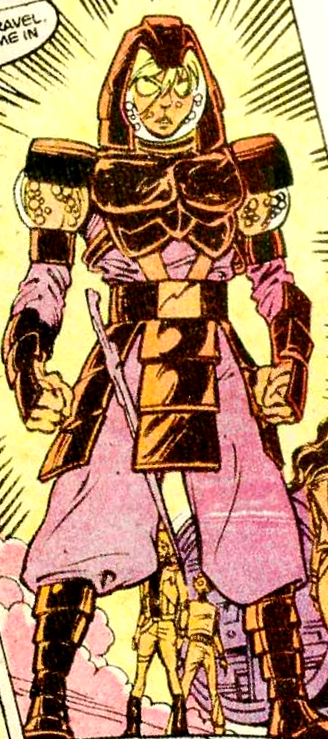 Like last issue, Ken Feduniewicz's colouring is erroneously credited to Glynis Wein, but unfortunately his work here isn't terribly good. He makes some weird colour choices, like having Dani rendered as white skinned, with cerise eyes in one panel – almost like a Zeltron albino! Then, in another panel, the green skinned Chido suddenly becomes orange and overall there are some odd colouring choices that don't serve the art as well as they could. Overall, Star Wars #82 feels kind of a dull when compared to some of the exciting and poignant issues that we've had of late. It's good to see Duffy trying to move the characters and storyline forward by having the former Rebellion attempting to unite the galaxy in the wake of the Empire's collapse, but nothing terribly interesting happens in this issue. Yes, it's good to revisit Iskalon and to see Mone and Kiro again – not to mention Rik Duel, Dani and Chihdo – but this issue seems too full of talk, without much action or any real sense of urgency to Luke's mission. Two issues into the post- Return of the Jedi continuity and we're already starting to miss the presence of the Empire as a legitimate threat to our heroes and as a device to drive the narrative forward. Continuity issues: - C-3PO tells Luke Skywalker that he needs to remain on Endor to translate the Hoojibs' dialect for Chewbacca. However, the Hoojibs communicate telepathically and therefore Chewie wouldn't need 3PO to translate for him.
Favourite panel: 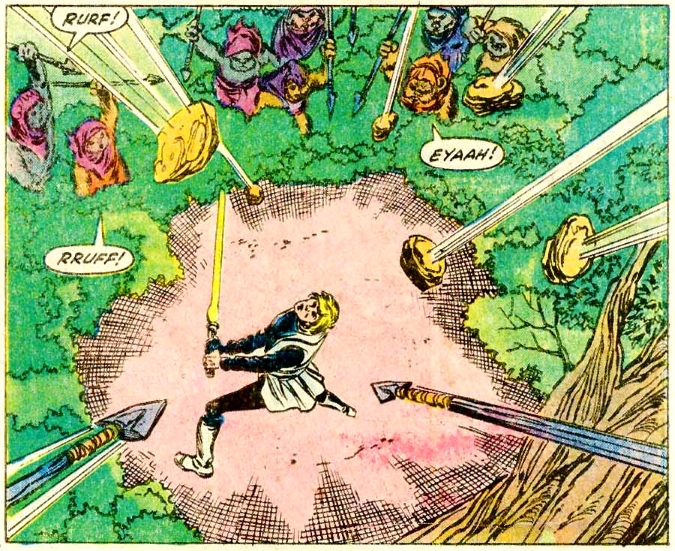 Favourite quote Favourite quote: "Oh … well done, Luke … very impressive. There's nothing like seeing a guy beat up a bunch of cute little creatures a third his size to give you a good impression of his fighting skills." – Lando Calrissian good-naturedly teases Luke Skywalker about using the Ewoks to help him with his combat training. I thought this was a decent issue. I think Duffy has done a logical thing in having the rebel leaders forming a new democracy, and also offering planets the chance to participate in councils for forming a new government, and recognizing that, evil as the Empire was, it did unite the planets. I also agree that Luke is a logical choice to send on some diplomatic missions like that, as a war hero. They didn't really give Luke a briefing on what exactly he's supposed to say to these world leaders, but what the hey. I also agree with Confessor that breaking our heroes up into groups increases the story potential, plus it seems reasonable that they're not all going to be joined at the hip anymore. In this issue, Luke levitates an Ewok, then later Chihido (a Rodian). I don't recall a Jedi (or Sith, for that matter) ever levitating a living being in the movies. Droids, yes, but living being, no. It wasn't really clear to me if they're capable of that or not. A nit here, but at the end, Luke says Rik is headed in the same direction as he is, but how would Luke know that? Rik certainly hadn't told him where, if anywhere, he was going next. And yes, it's usually not a good thing when the inker is "M. Hands" That guy is pretty inconsistent. |
|

























































